Pre-1900
Ads
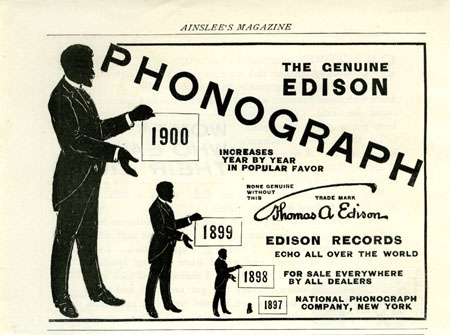
Trade and Popular Culture
Magazine Ads
By Doug Boilesen 2019
The introduction of the coin-in-the-slot
phonograph in 1889 was a pivotal step for the phonograph to become
a music and home entertainment machine. These early jukeboxes played
music and recitations using cylinder records such as the ones in
Edison's first catalogue in 1890 which were called 'Musical Phonograms."(3A).
The Columbia Phonograph Company made
their graphophone machine and some of their earliest records featured
music played by the U.S. Marine Band. Other companies and individuals
would likewise make records for the coin-in-the-slot machines located
in saloons, hotels, restaurants, train and ferry stations, and other
public places.
FACTOLA:
The first nickel-in-the-slot phonograph was installed November 23,
1889, by Louis Glass inside the Palais Royale Saloon in San Francisco.
The commercial success
of these early coin operated phonographs led to the introduction
of easier to operate, cheaper, spring-powered phonographs which
in the mid-1890's would be made and increasingly targeted for the
home.
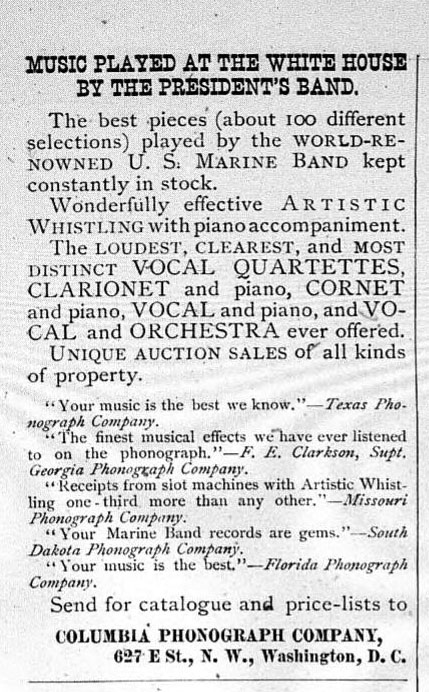
Columbia Phonograph advertisement
for records. The Phonogram, February 1891
The Phonogram in March 1892 reported
that the United States Marine Band was engaged in recording for the
Columbia Phonograph Company "an immense stock of records...the
largest ever thus accumulated in the business." Columbia "now
claims the bulk of the musical record business of the United States."
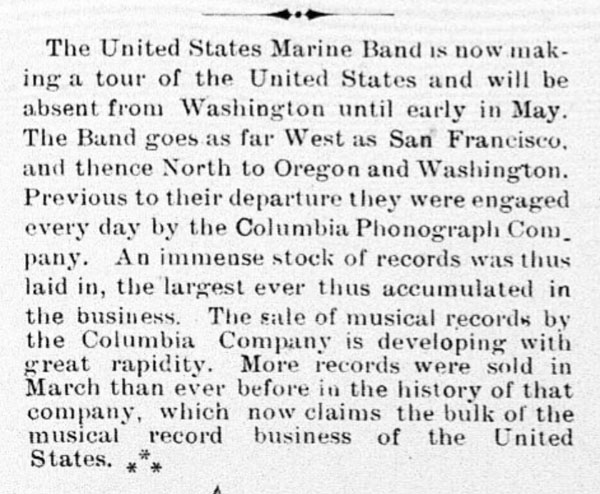
The Phonogram, March
1892
The following ad, published as one of
the Reading Notices in The Phonogram of March
1892, publicized Mr. AtLee, the artistic whistler known for his remarkable
performances "presented through the phonograph" now with
three new records. "Two of these represent the notes of birds--a
mockingbird and a boblink: the third is the version of an air from
the opera of Anna Bolena, known to most persons under the popular
name of "Home, Sweet Home."
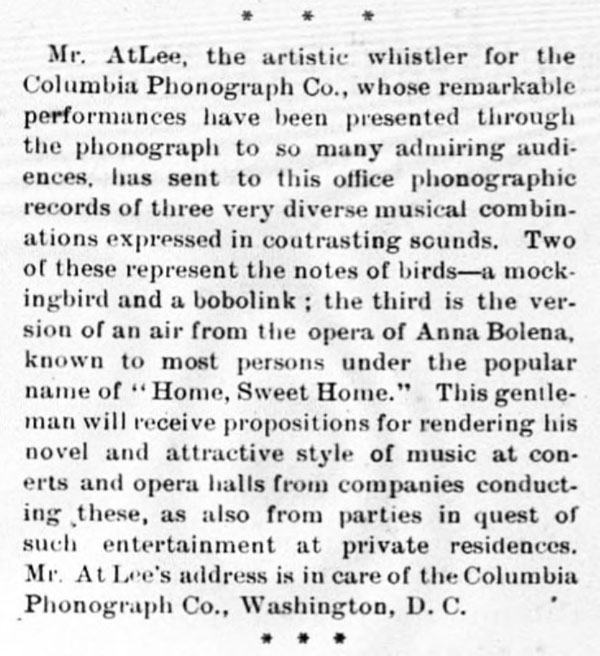
Reading Notices. The
Phonogram, March 1892
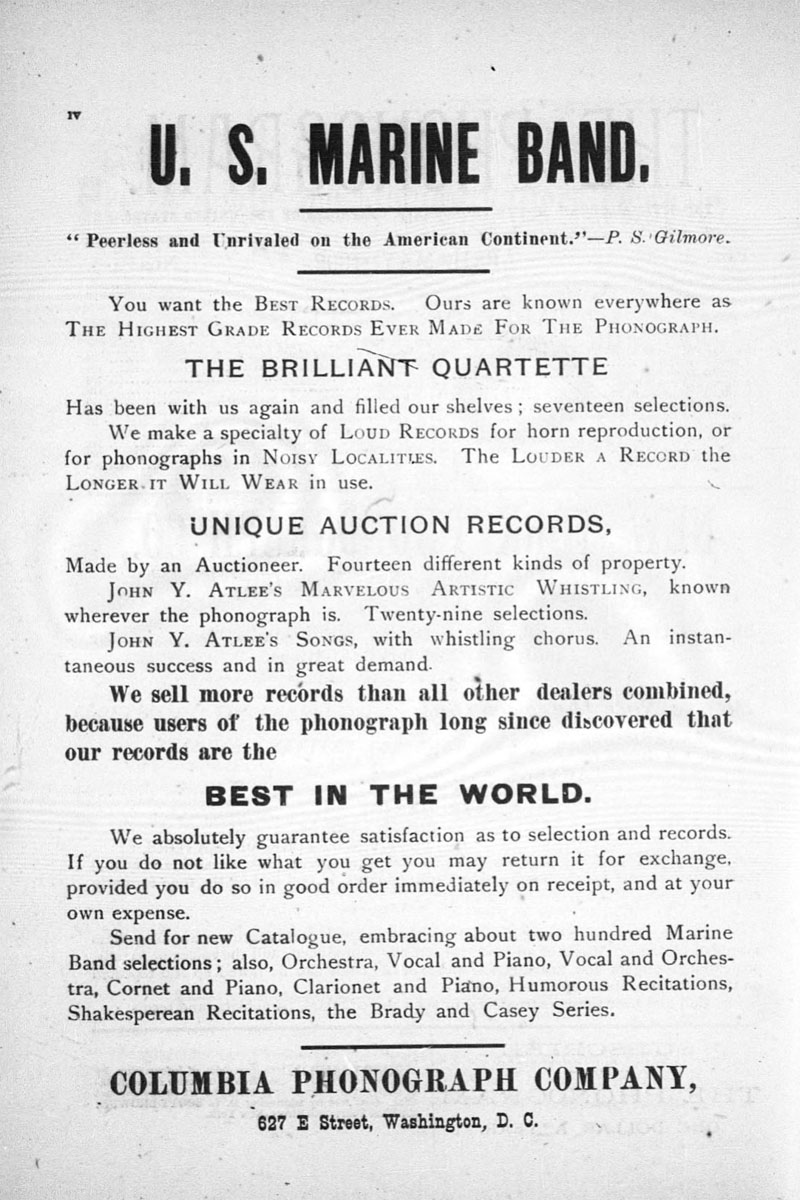
Columbia Phonograph
Company - "Our records are the BEST IN THE WORLD,"
The Phonogram, April-May 1892
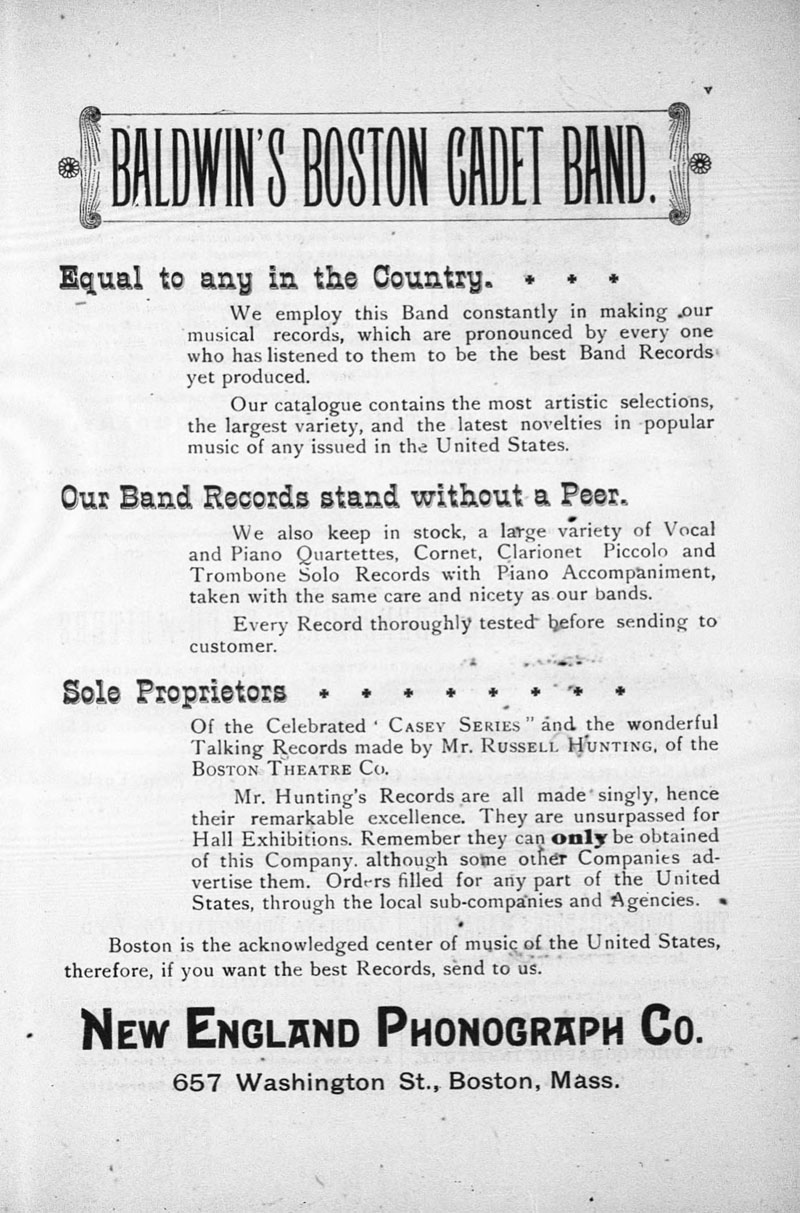
New England Phonograph
Company - "Boston is the acknowledged center of music of
the United States."The Phonogram, April-May 1892
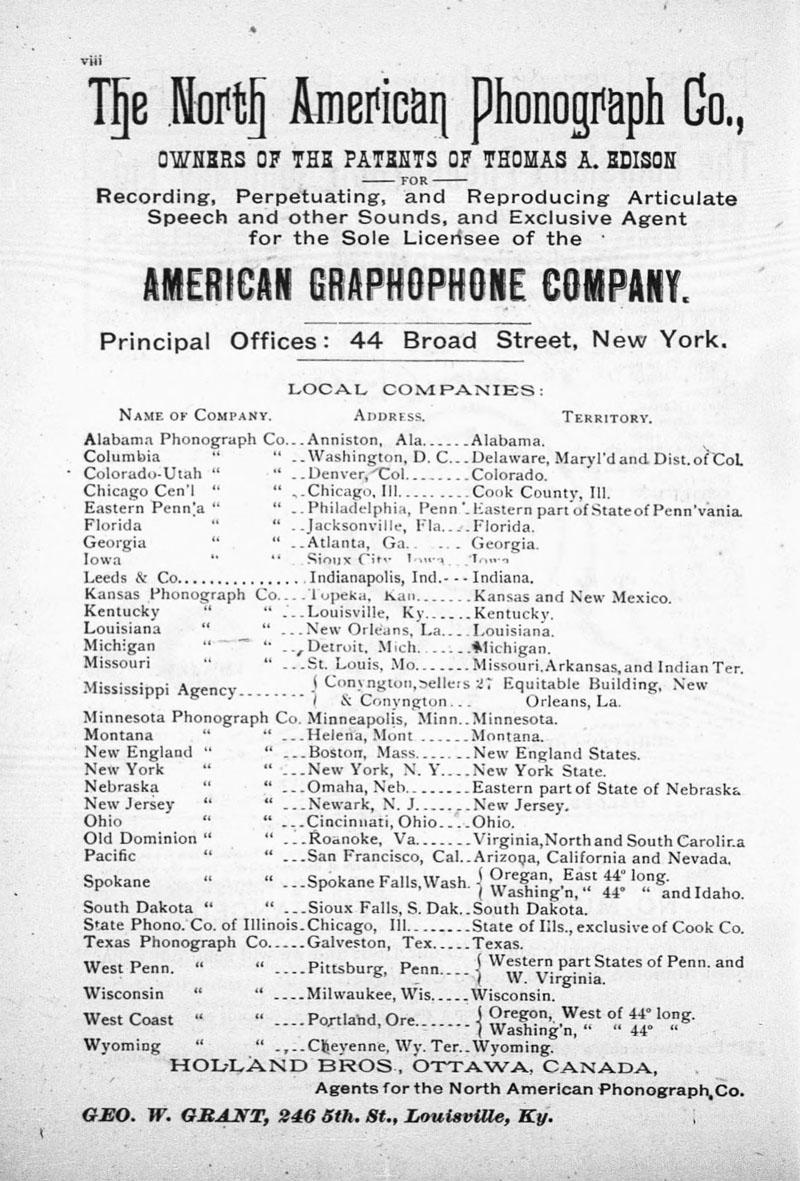
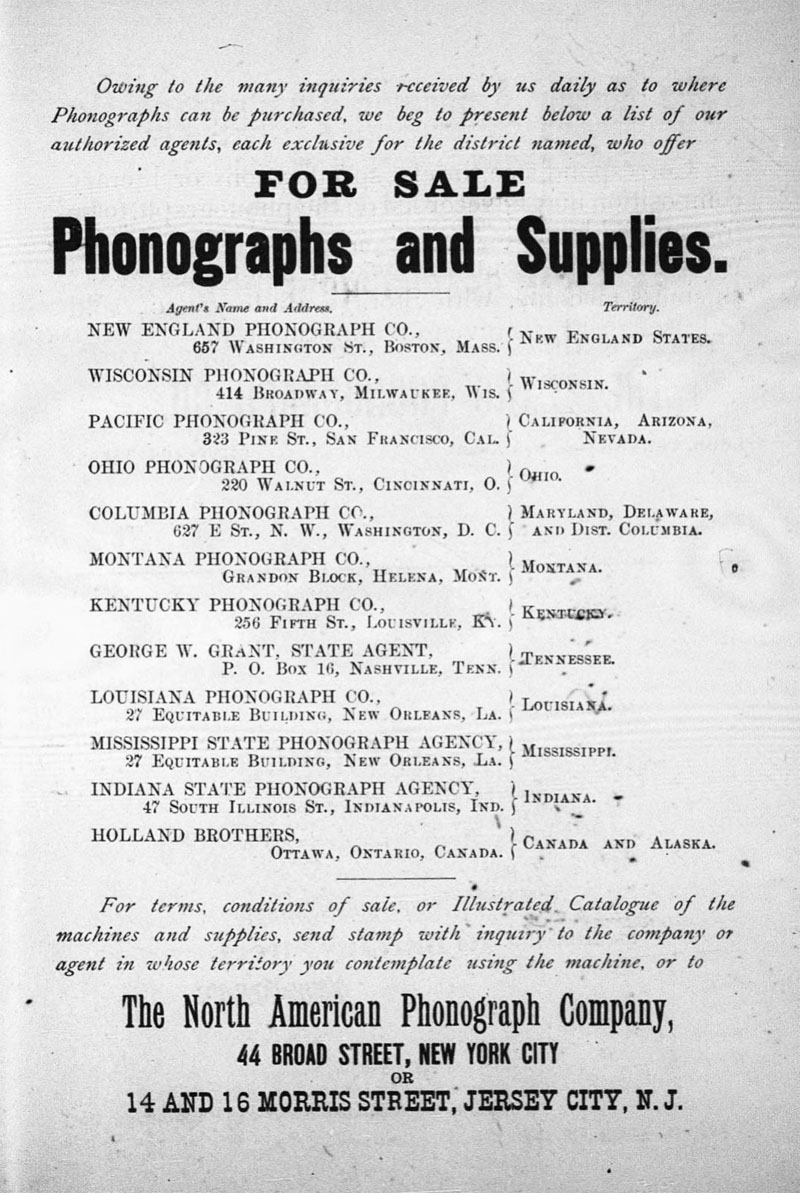
The North American
Phonograph Company - "For Sale Phonographs and Supplies."The
Phonogram, April-May 1892
In 1893 the North American Phonograph
Company produced a brochure with page 1 headlined THE EDISON
PHONOGRAPH AS THE MEANS OF HOME ENTERTAINMENT followed by
"It is doubtful if any other
instrument for Home Entertainment has sprung into popularity
so quickly as the Edison Phonograph....The public soon realized
the pleasure to be derived from hearing reproduced on this wonderful
machine the efforts of distinguished Musicians, Singers and Comedians,
with every characteristic of the artist as to expression, technique
and feeling as faithfully reproduced as though the listeners heard
the actual efforts of the person who had rendered his talent to
the machine." (1)
The machine and accessories for the
RESIDENCE described in this brochure, THE EDISON PHONOGRAPH
OUTFIT FOR HOME AMUSEMENT, was expensive (ranging from $175.00
and up). Four different classes were offered "according to whether
it is to be run by an Electric Motor and batter; an Electric Motor
attached to an Electric Light Current; a Water Motor; or a Foot Treadle."
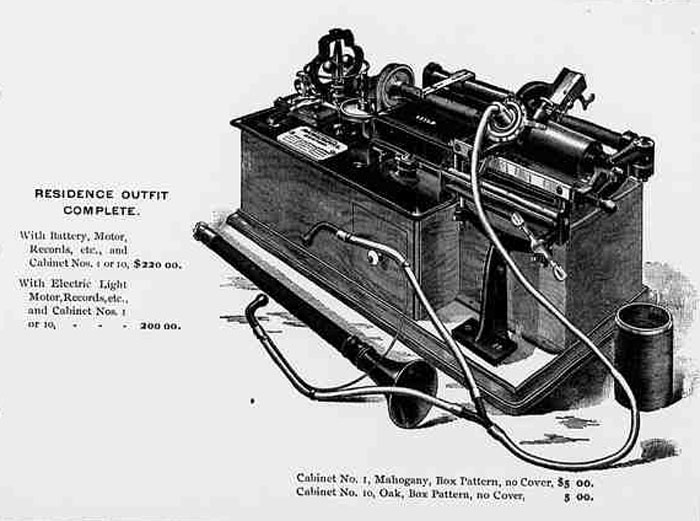
North American
Phonograph Company - 1893 brochure from The Thomas Edison
Papers, Rutgers
When cheaper, spring wound phonographs
began to be marketed by Columbia in 1895 as a home entertainer its
ads focused on simple themes: it laughs, talks, sings and can repeat
your own voice or song; it plays loudly and clearly; it was easy to
operate.
Munsey's Magazine,
September 1896
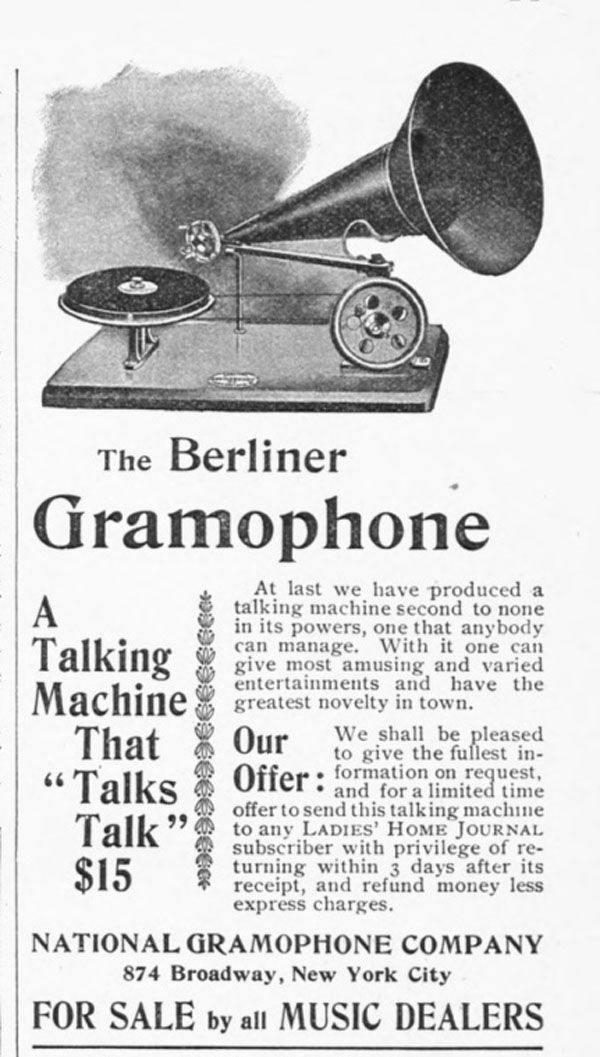
The Berliner Gramophone,
The Ladies' Home Journal, September 1896
"Edison’s newly organized (Jan.
24, 1896) National Phonograph Co. was soon offering its first spring-wind
model at $40" in April 1896 and in October Edison would be
selling their "red and gold ‘Home’ decoration on the lid"
phonographs as seen below in the Phonoscope, November 1896.
(see Allen Koenigsberg, They
Echoed All Over the World” ...But When Did the First ‘National Phonograph’
Cylinders Appear?, The Sound Box, December 2011, p. 28).
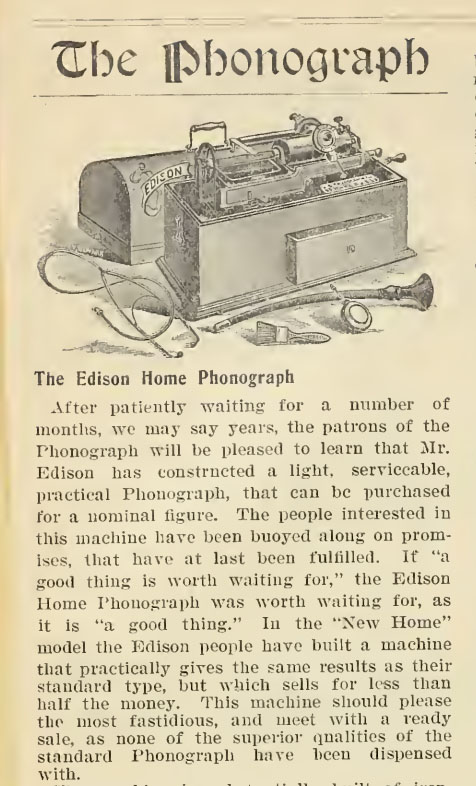
Announcement of the Edison
Home Phonograph, The Phonoscope, November 1896
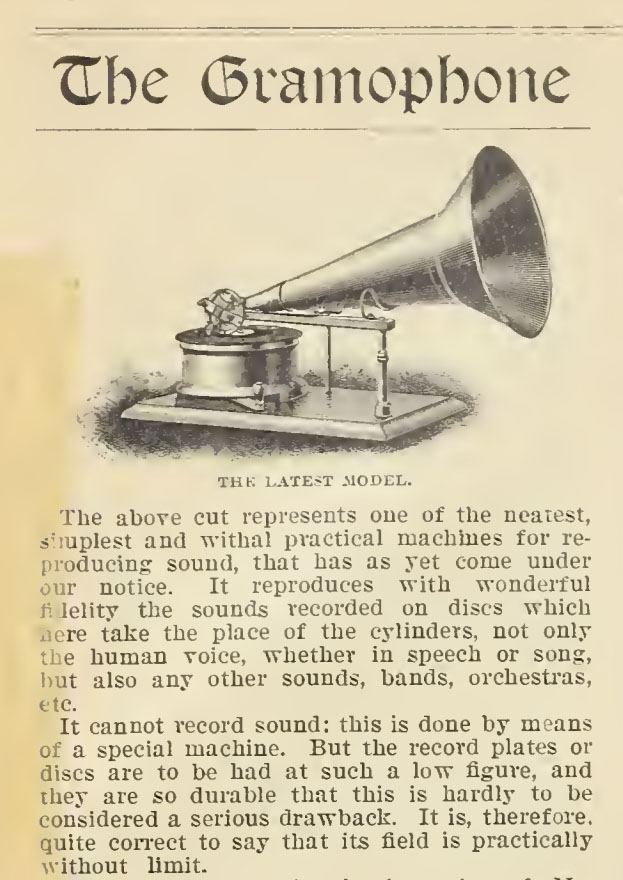
The Phonoscope,
November 1896
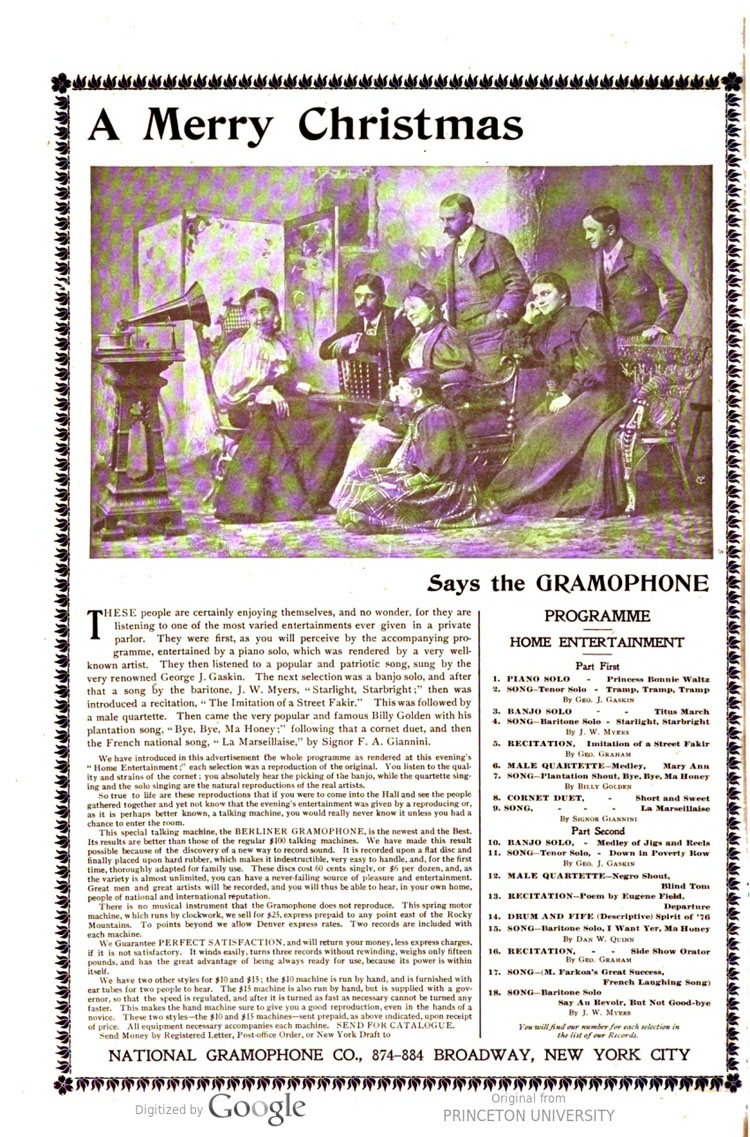
The Outlook, November 28, 1896
(back cover) - Note: Earliest known version of this ad was published
in The Christian Work, November 19, 1896 p. 822. (Courtesy
Allen Koenigsberg)
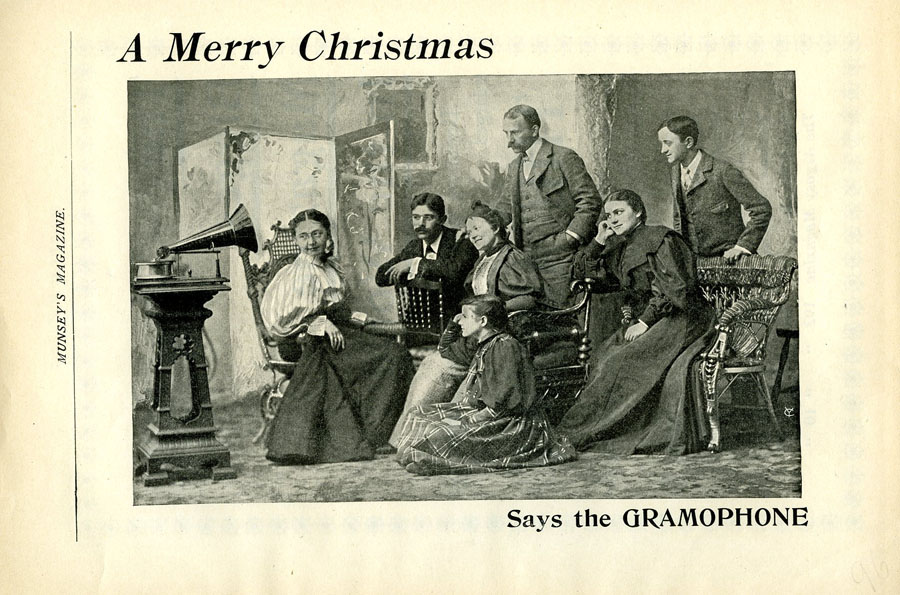
Munsey's Magazine,
December, 1896 (PM-910)
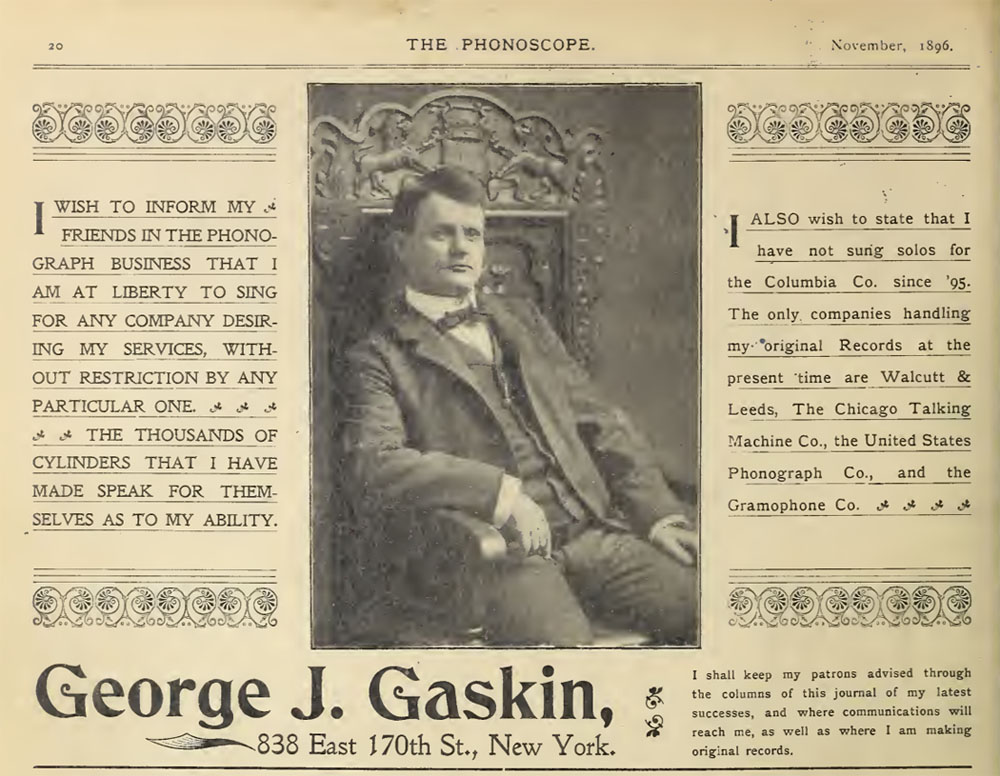
Trade magazine ad by George
Gaskin making his services known as available to all record companies,
The Phonoscope, November 1896
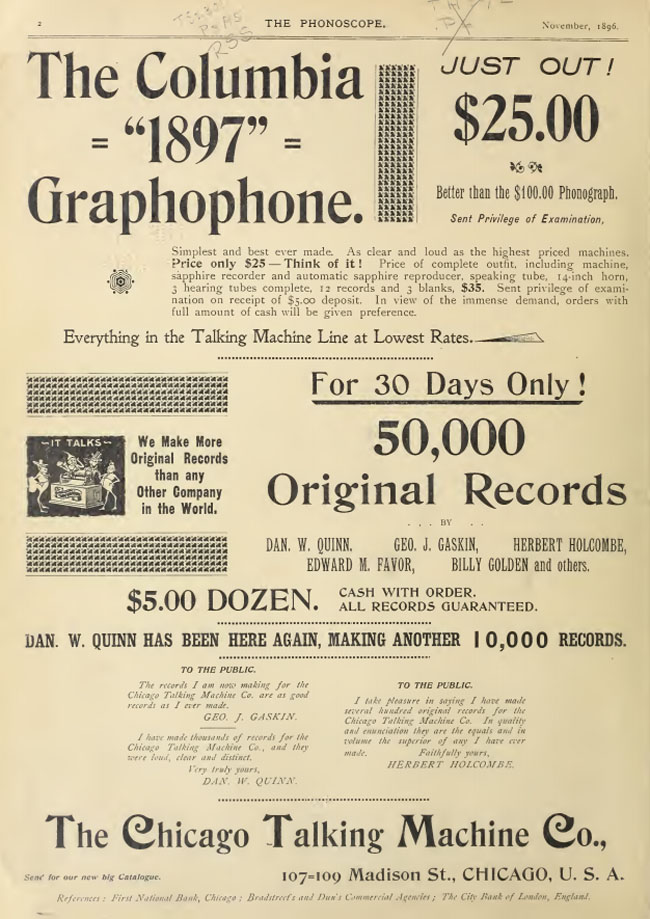
"Simplest and best
ever made" advertisement for Columbia's 1897 Graphophone, The
Phonoscope, November 1896
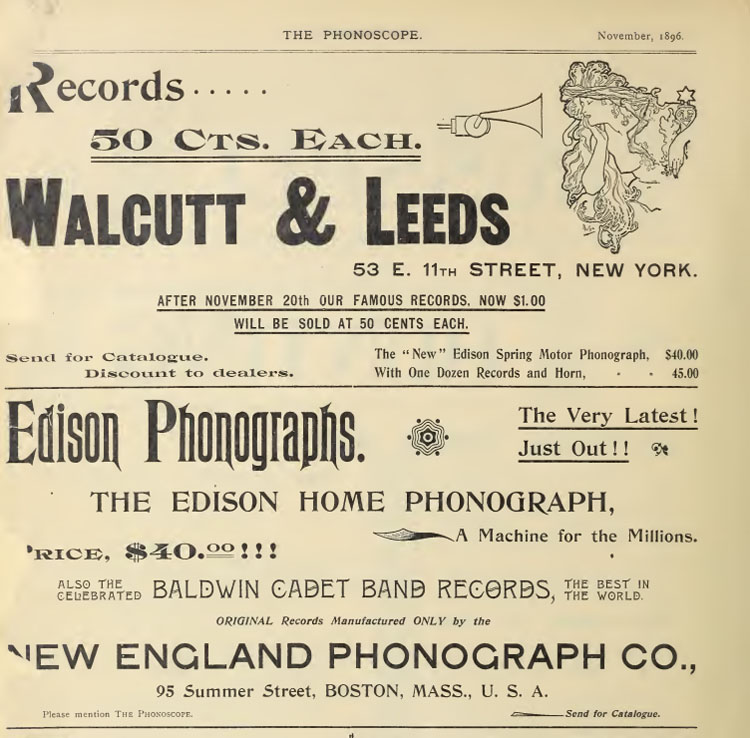
Top half page ad Edison
Home Phonograph and Walcutt & Leeds Records, The Phonoscope,
November 1896
One early star of story telling was
Russell Hunting, known for his 'Michael Casey' recordings. Hunting
placed a full page ad in The Phonoscope's initial edition in
November 1896 and stated "I can supply you with a meritable record
at a reasonable price."
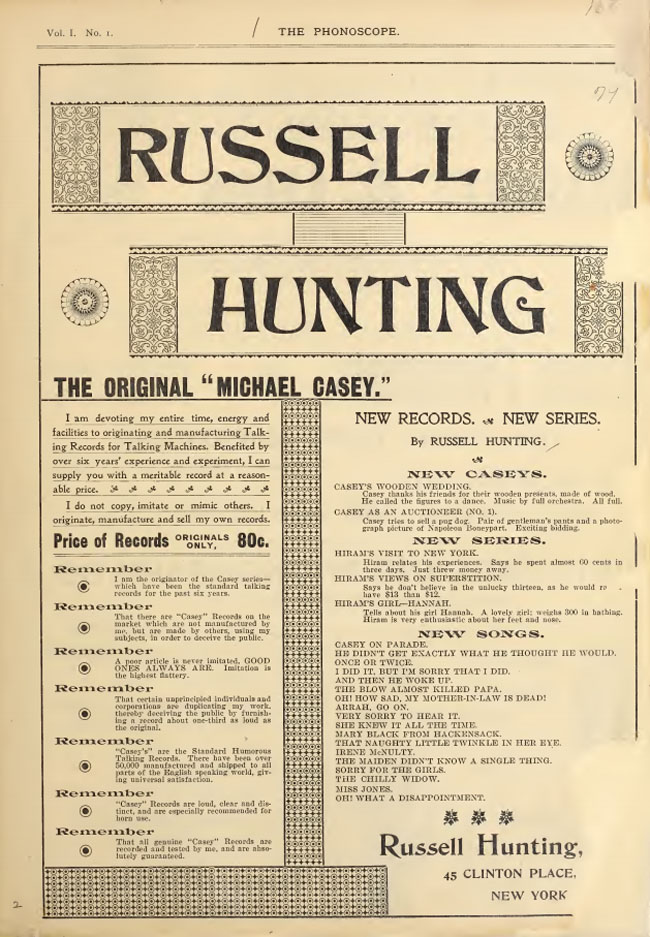
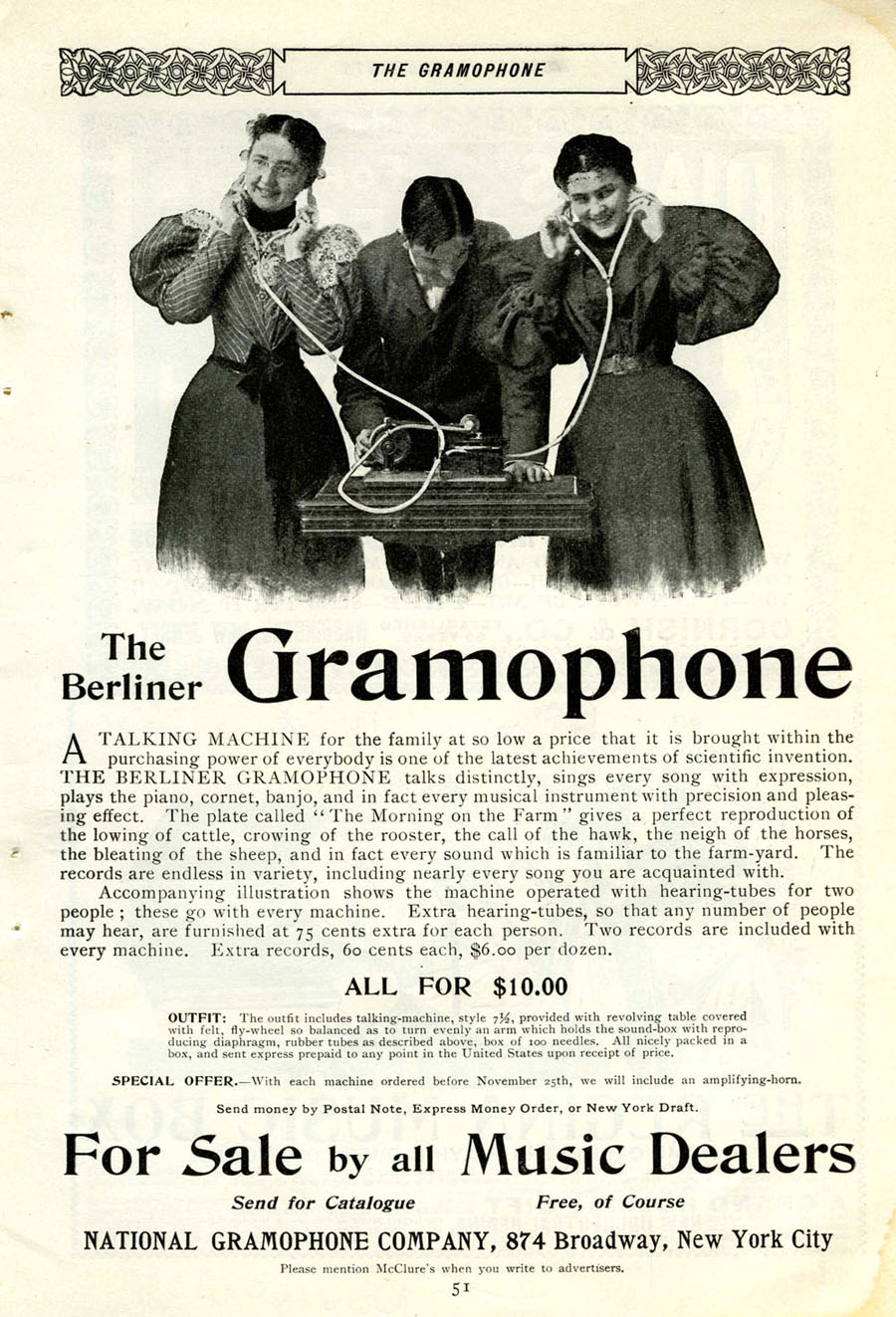
"The records are endless in variety..."
McClure's Magazine, November, 1896 (PM-0907) (also back
cover of The Outlook, October 31, 1896, et al.)
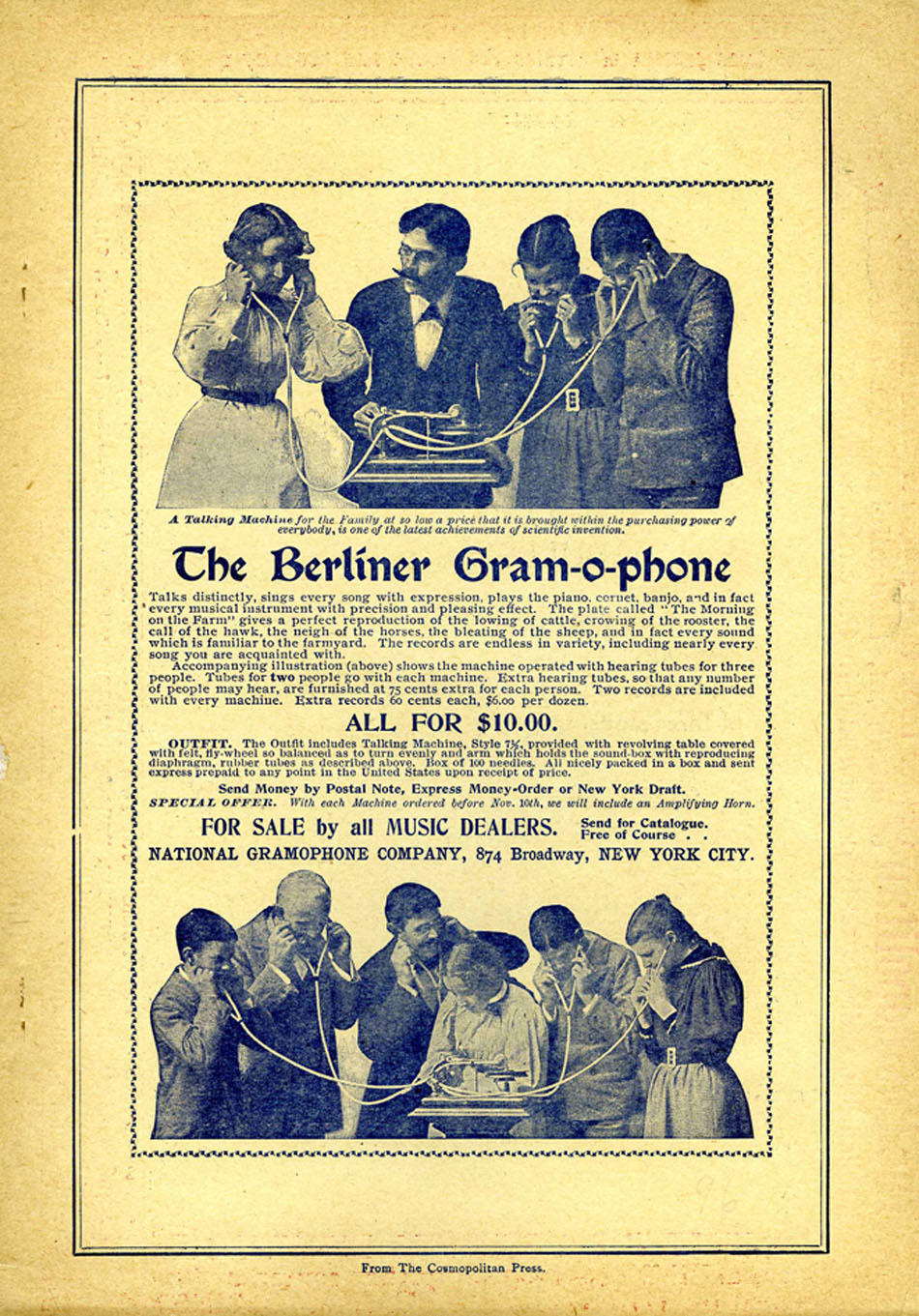
"A Talking Machine
for the Family..." The Cosmopolitan Magazine, November,
1896 (PM-0909)
Endless variety, however, didn't normally
include specifics in the ads about who the actual artists were that
were performing. Caruso and the Metropolitan's divas were not yet
part of the "limitless reportoire" that an 1897 Columbia
Graphophone ad said was now available. Instead, this reportoire constituted
music "rendered by celebrated orchestras and bands, vocal and
instrumental music, recitations, speeches, etc."
There were references in trade magazines
to a few early recording stars like Dan W. Quinn, Geo. J. Gaskin,
Edward M. Favor, Billy Golden; and some true celebrity recordings
were being made in the 1890's, most notably by Gianni
Bettini in his New York City phonograph salon and Julius
Brock (1A) in Europe. Popular culture did have their own early
recording stars like artistic whistling John Atlee and band music
played by the "world-renowned U.S. Marine Band could be heard
on "about 100 different selections" in 1891.
But celebrity music wasn't what
the public was expecting to hear on the coin-in-the-slot machines.
And it wasn't what they would hear on the early records that came
into the home.
The general public from 1895 to 1900
saw magazine phonograph advertisements which had a priority of selling
a phonograph to the home. The ads focused on the machine and not specific
recording artists. The phonograph in early ads was seen as an opportunity
for the home to hear “the world’s greatest Musicians, Singers, Actors,
and Speakers..."; "the best bands"; "celebrated
orchestras and bands." And the first step was to get consumers
to buy a talking machine.
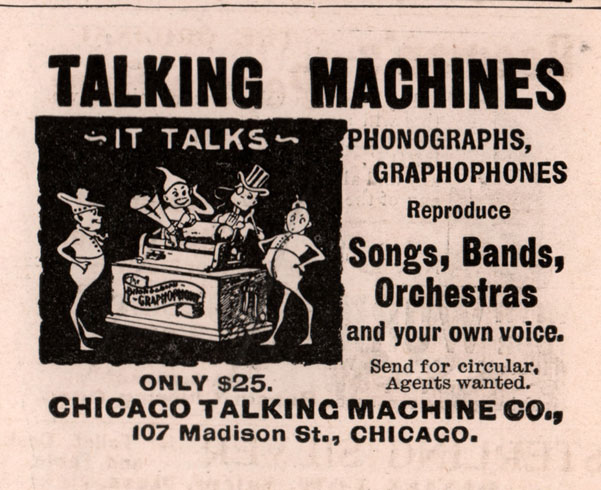
The Chicago Talking Machine
Co., The Phonoscope, November 1896
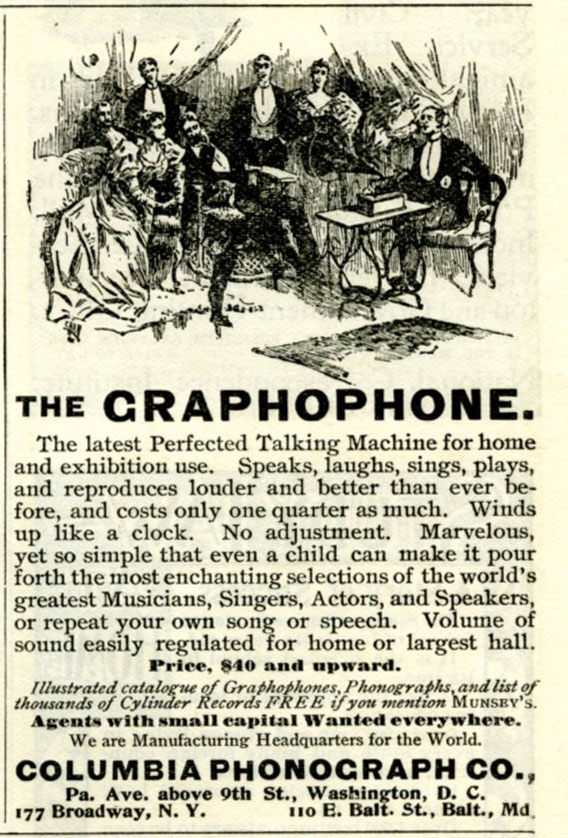
"Marvelous, yet so simple
that even a child can make it pour forth the most enchanting selections..."
Munsey's Magazine, 1896 (PM-1006A)
The "most enchanting
selections of the world's gr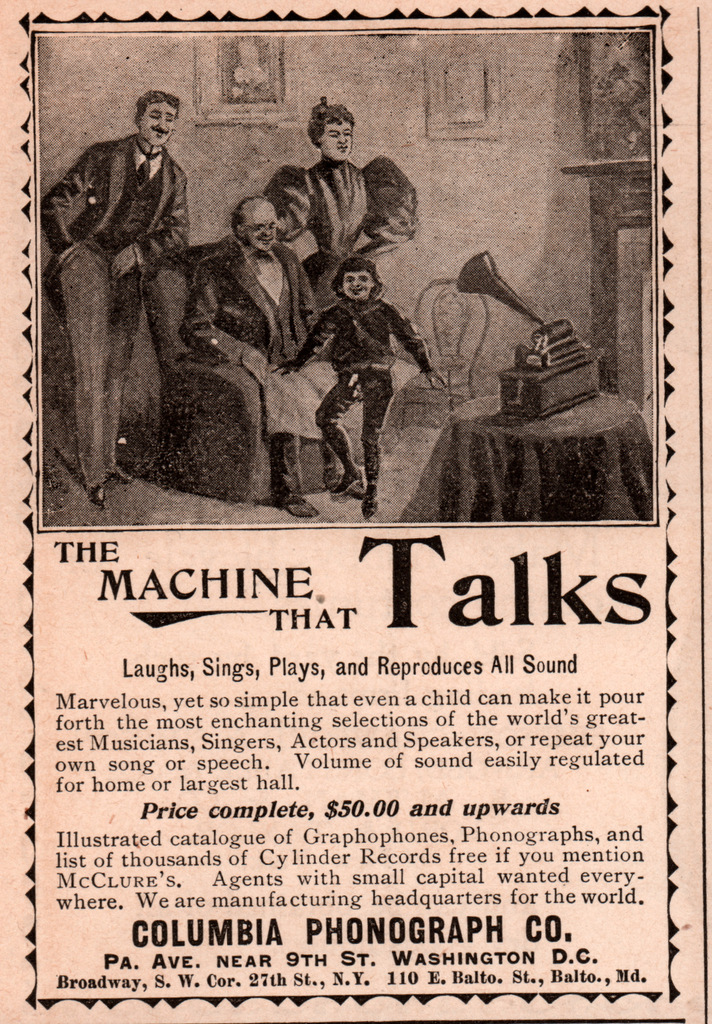 eatest
Musicians, Singers, Actors and Speakers..." 1896 eatest
Musicians, Singers, Actors and Speakers..." 1896
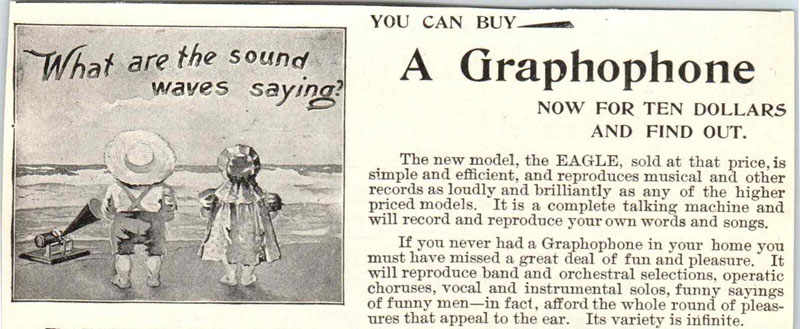
The Graphophone EAGLE for
$10.00, Strand
Magazine, Oct-Dec 1897 (per EBay ad).

The Edison Home Phonograph,
Strand
Magazine, Oct-Dec 1897
Selling the phonograph as a home entertainer
joined the three other phonograph markets -- as a machine for business
(dication and letter-writing); as an exhibition machine for phonograph
concerts (2); and as a machine
for the nickel-in-the-slot phonograph
business (3).
Each of the phonograph markets could
promote the phonograph as "marvelous," the "greatest
invention of the age (4) and the wonder of the world."
But what would have its greatest impact was as a home entertainer
a decade later when consumers started to understand that they didn't
need to leave their home to hear the 'greatest artists;" that
it didn't matter when or where the 'performance' had taken place because
it was available to you now and as often as you wanted; and that its
repertoire could even be accepted as "the
stage of the world" in your own home.
The "best seat in the house! Forever"
was the phonograph's fundamental premise and promise, and it would
be a theme repeated by each of its descendent home entertainment for
the next one hundred years.
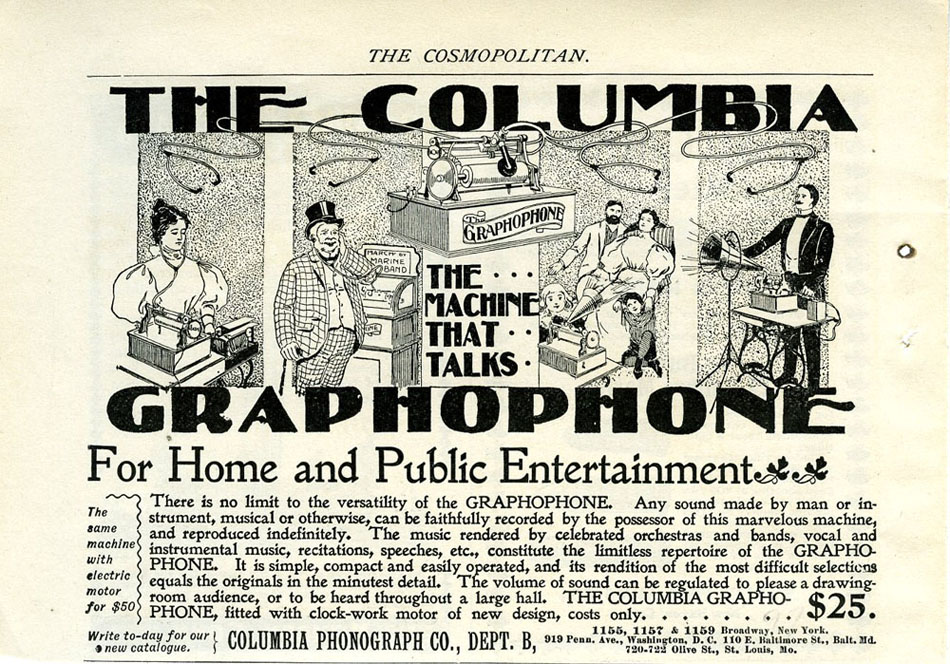
"no limit to the versatility of
the GRAPHOPHONE" and its "limitless repertoire". The
four competing uses for the phonograph in the 1890's: Business, Coin-in-the-slot,
Home Entertainment and Concert/Exhibitions. The Cosmopolitan,
1897 (PM-0920)
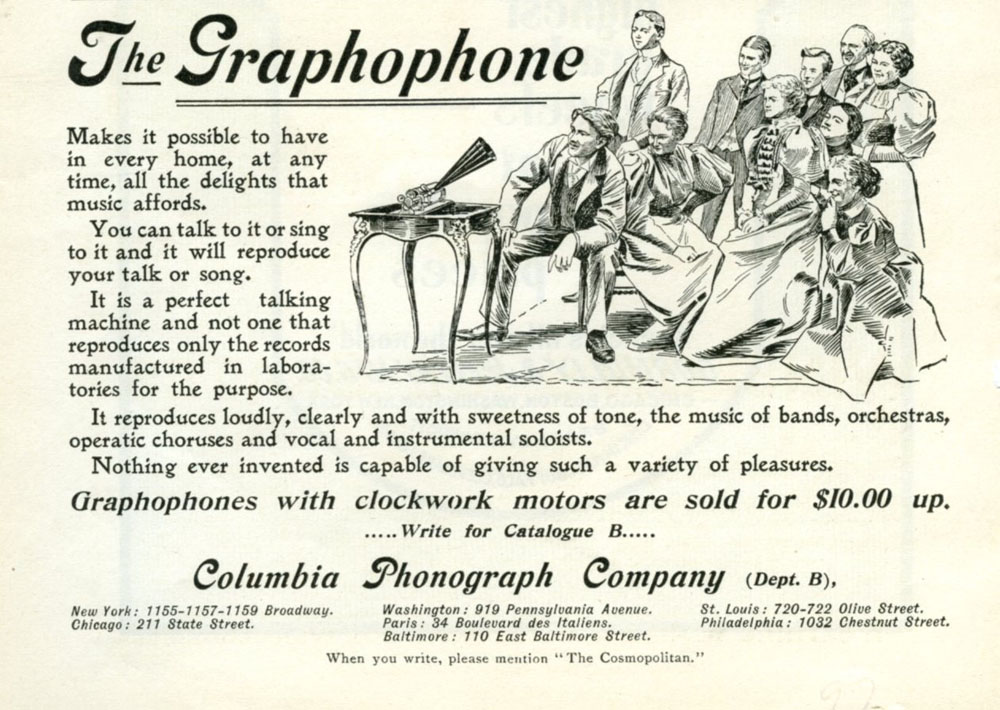
"Nothing ever invented
is capable of giving such a variety of pleasures." The Cosmopolitan,
1897 (PM-1008A)
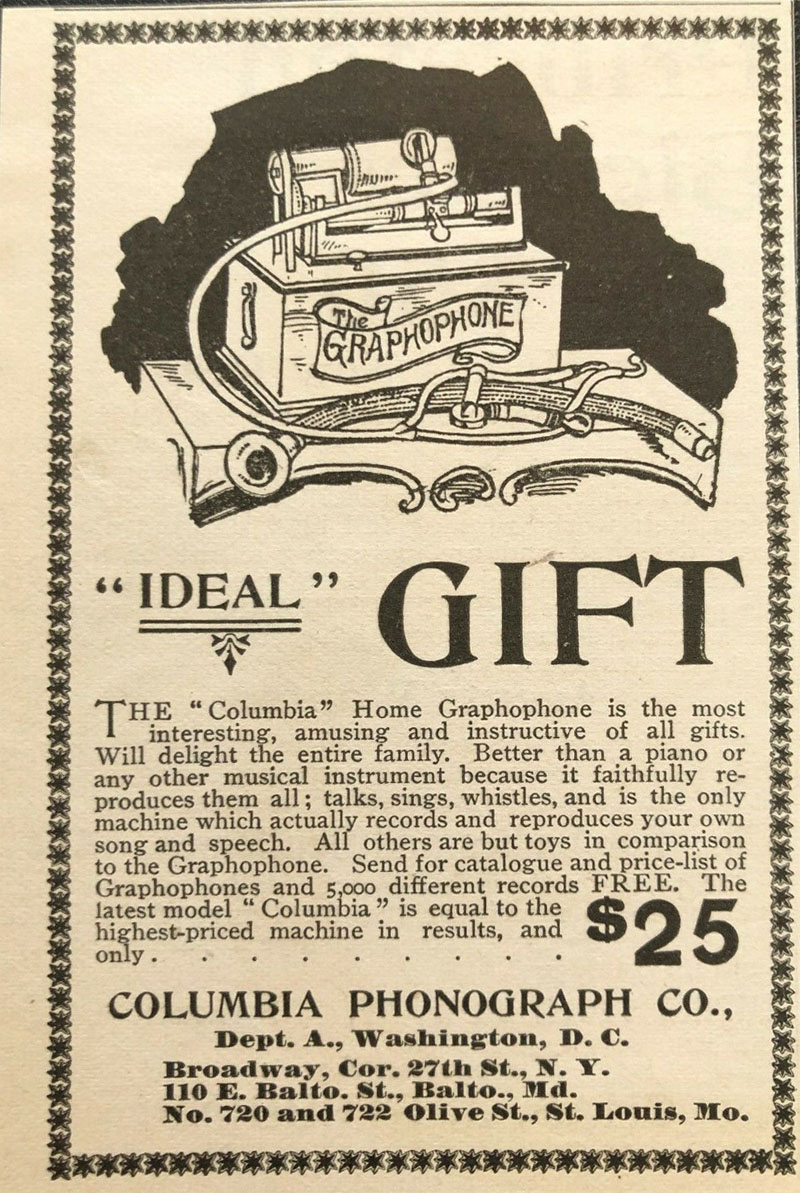
Munsey's Magazine,
January 1897
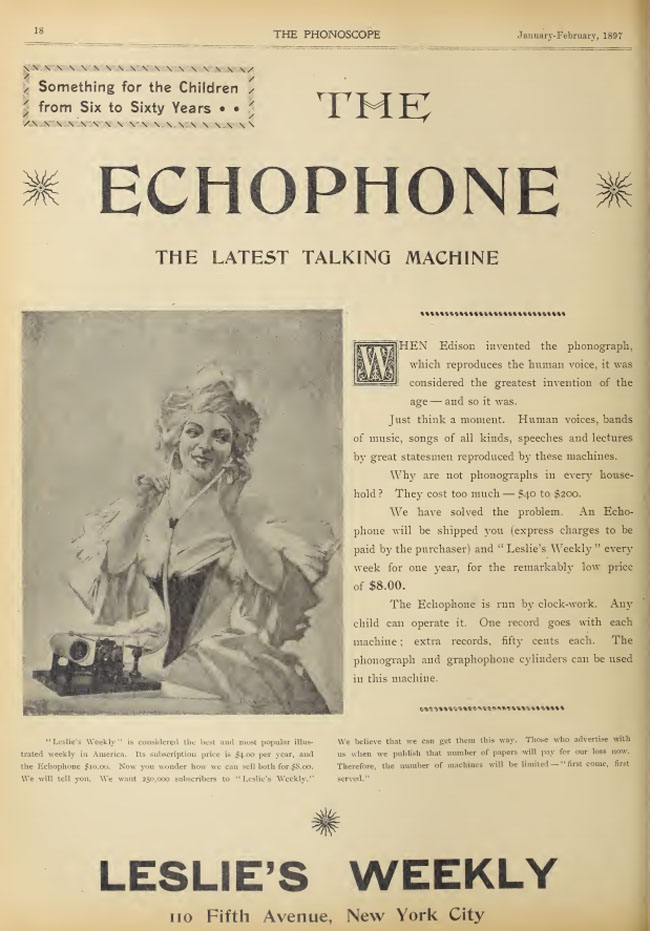
The Phonograph - "the
greatest invention of the age..." The Phonoscope, January
1897

Munsey's Magazine,
March 1897

Chicago Talking Machine
Co., Munsey's Magazine, May 1897
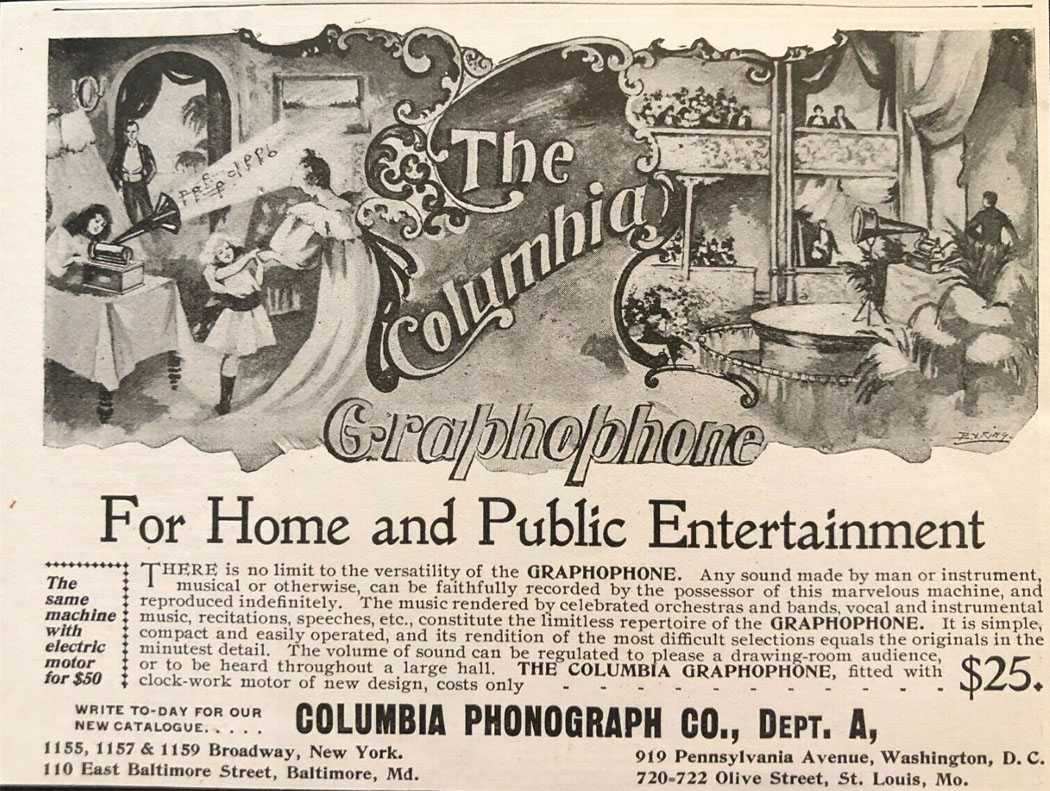
Munsey's
Magazine,
May 1897 (PM-1010A)
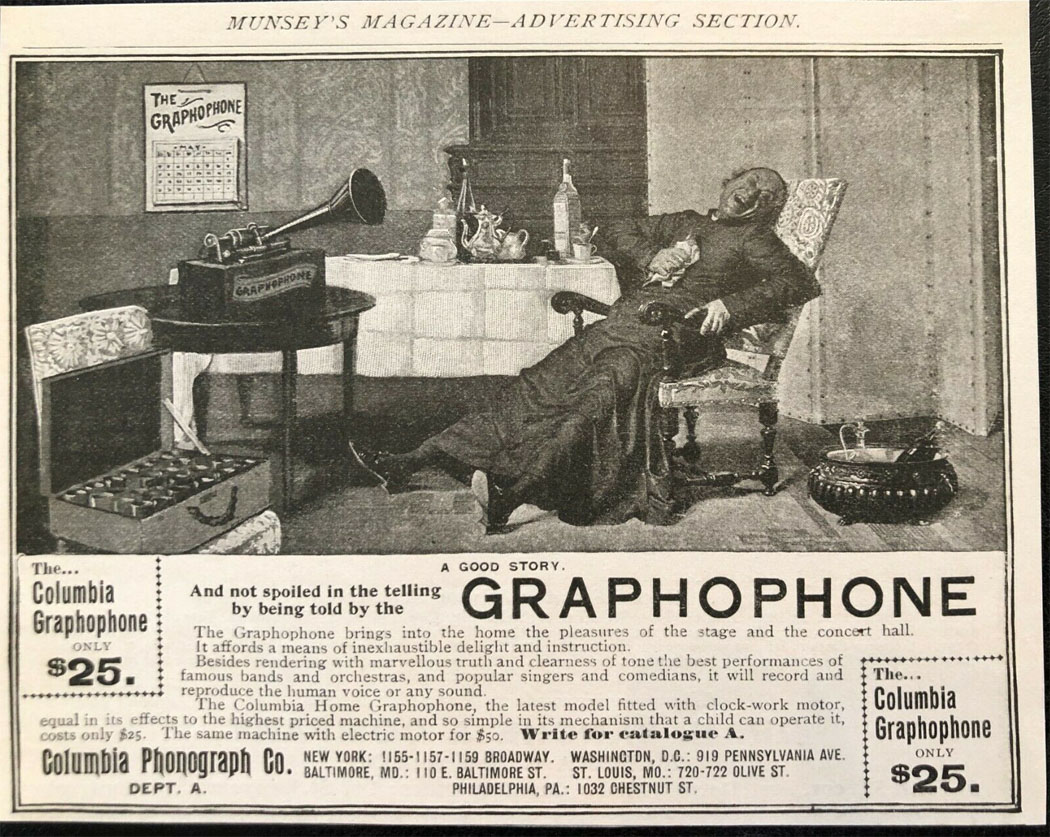
Munsey's Magazine,
July 1897 (PM-1009A)
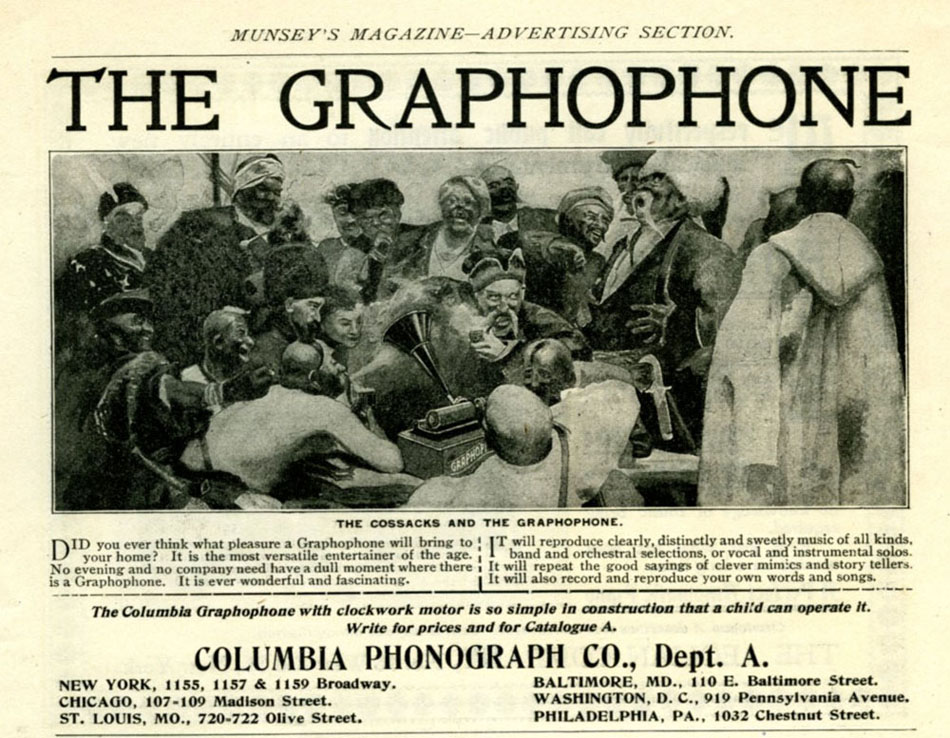
"It is the most versatile
entertainer of the age." Munsey's Magazine, 1897
(PM-1020A)
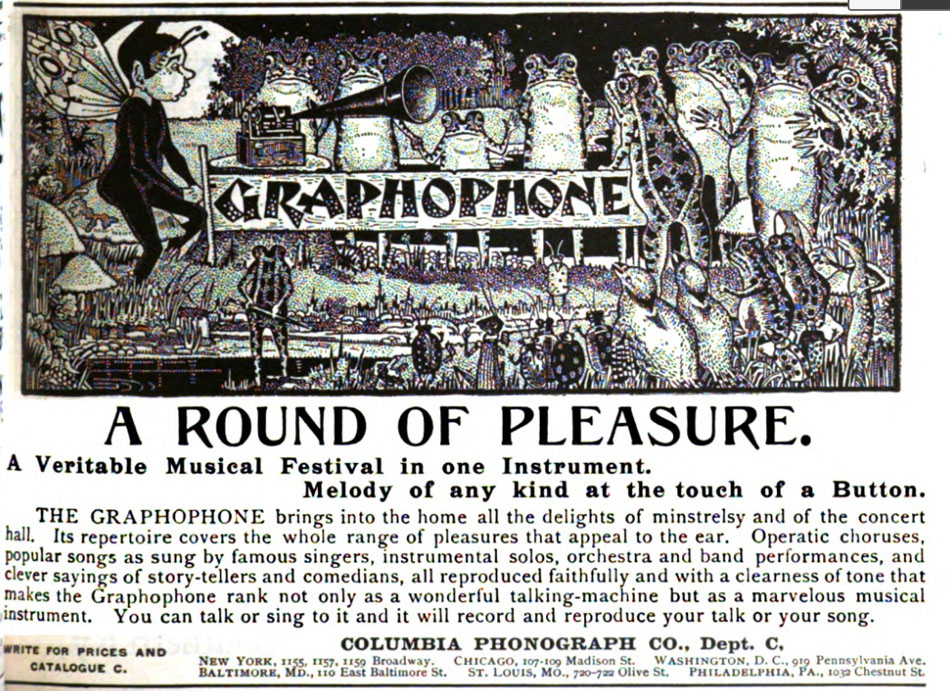
"A Round of Pleasure"
- The Graphophone brings into the home all the delights...." McClure's
Magazine, August 1897
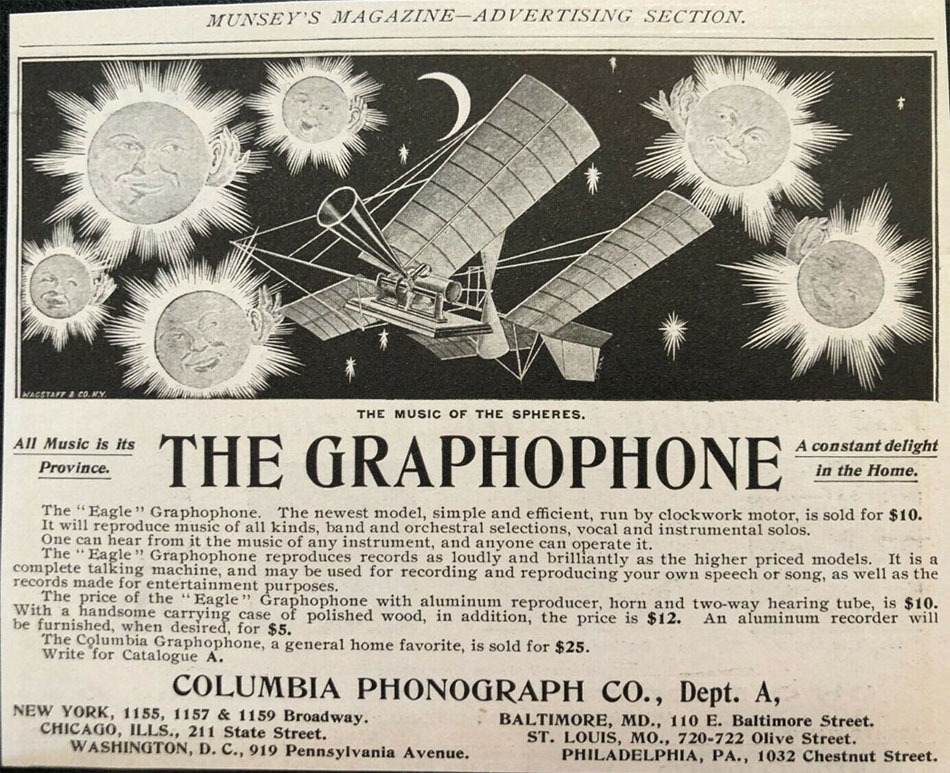
The Music of the Spheres. All Music is its Province. Munsey's
Magazine, October 1897
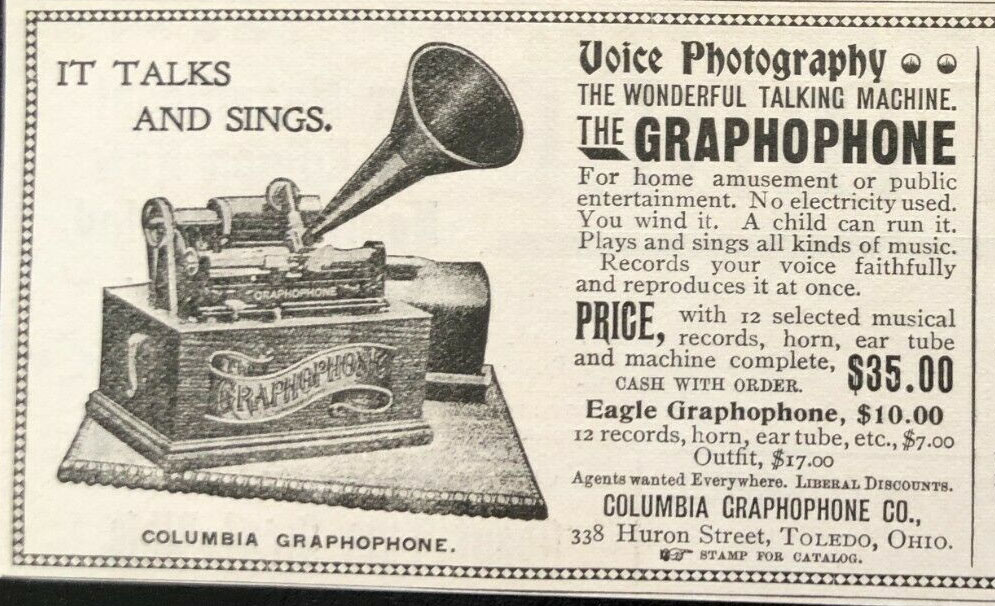
Munsey's Magazine, October 1897
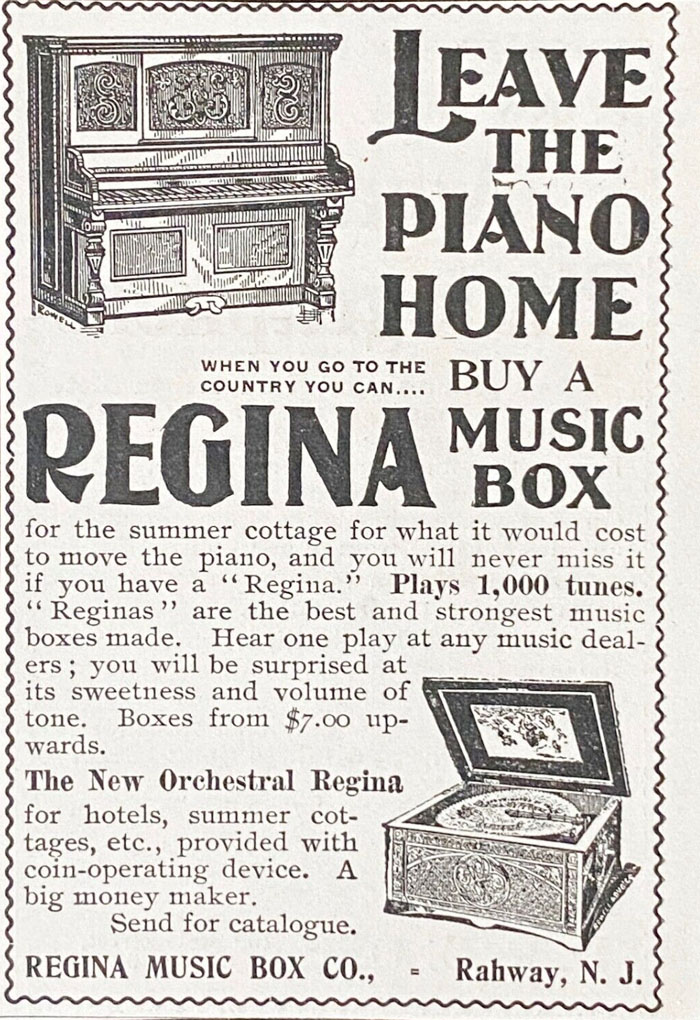
This June 1897 Regina Music Box ad is
inserted here as a reminder that the phonograph had significant home
entertainment rivals in 1897. The music box industry which had thrived
in the 19th century would be particularly challenged by the phonograph
and Regina, a market leader in the music box industry went bankrupt
in 1922. For an interesting story about Regina and the phonograph,
see Phonographia's The
Regina Company and What-if?
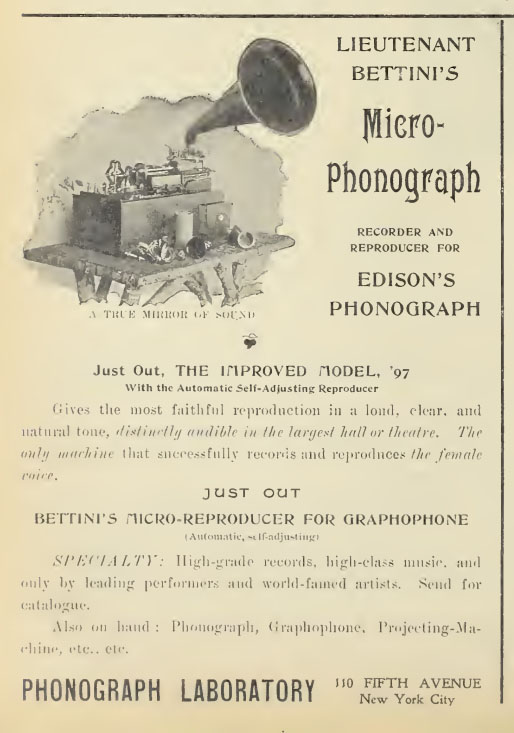
"A True Mirror of
Sound," The Phonoscope, March 1897
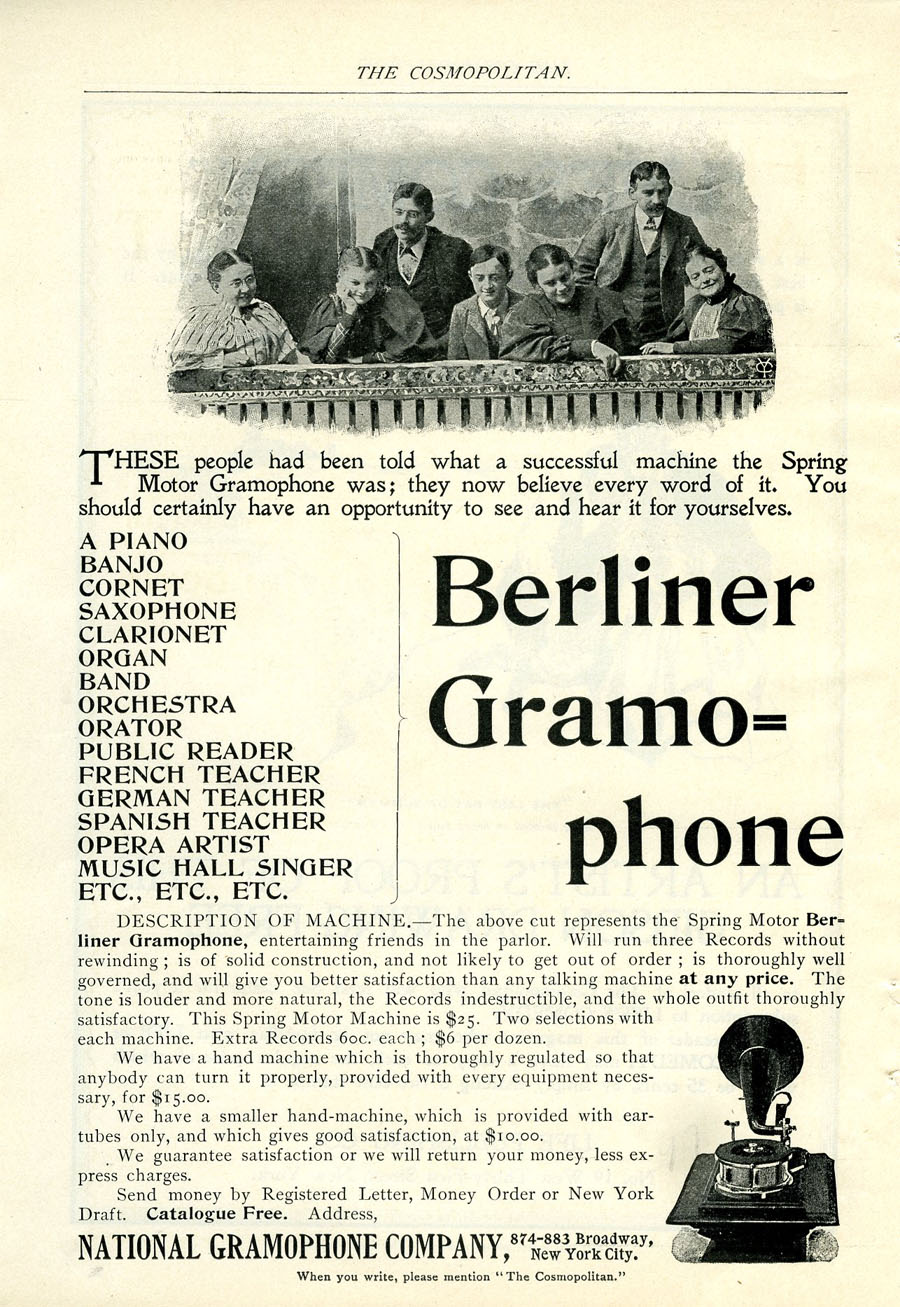
The Cosmopolitan,
1897 (PM-0914)
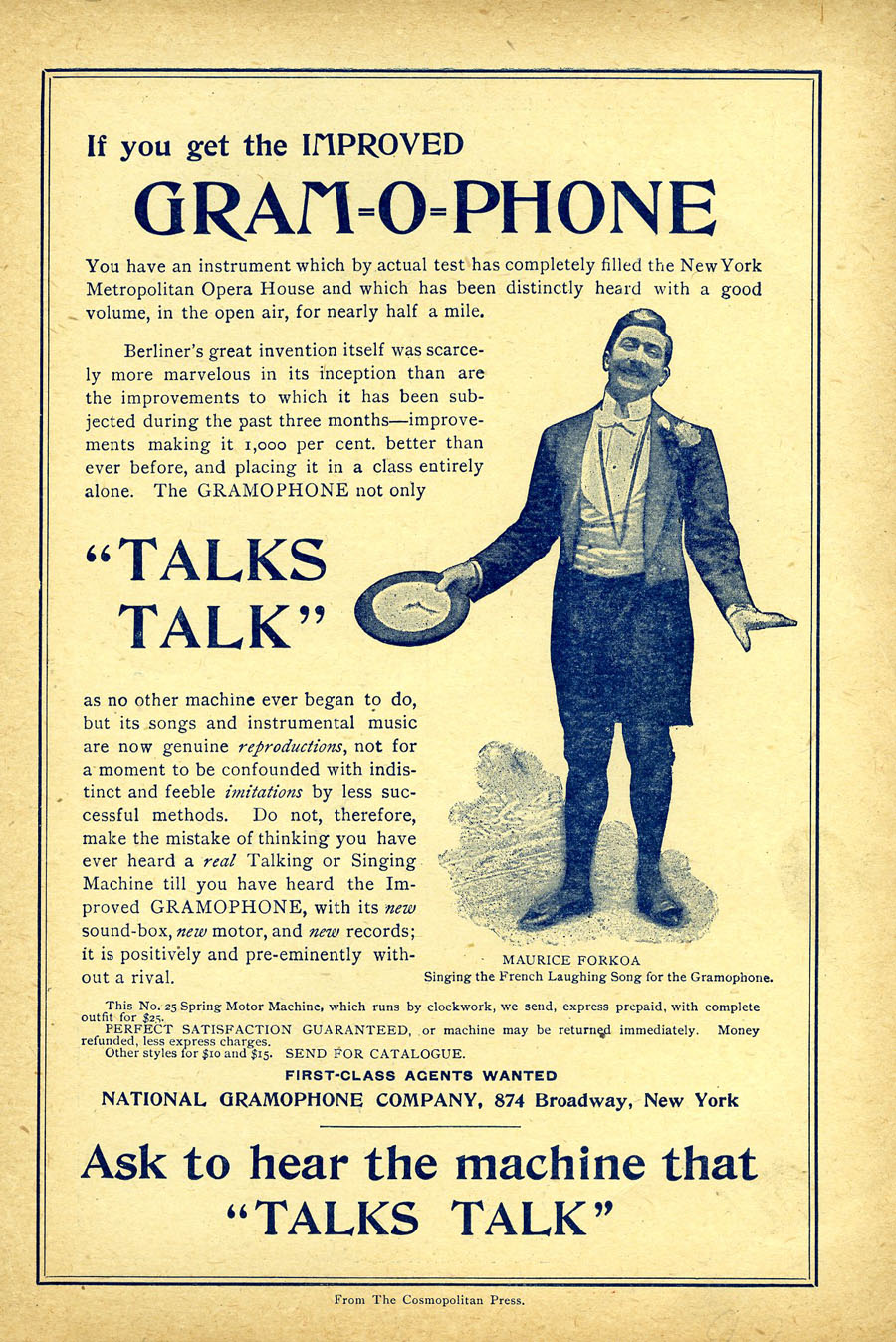
The Cosmopolitan,
1897 (PM-0912) (Also, McClure's Magazine, October 1897)
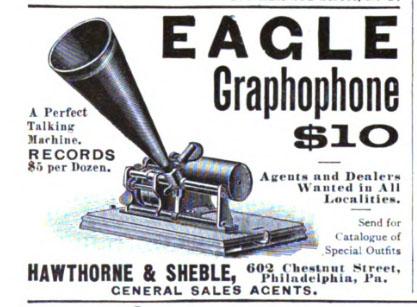
Eagle Graphophone $10,
McClure's Magazine, October 1897
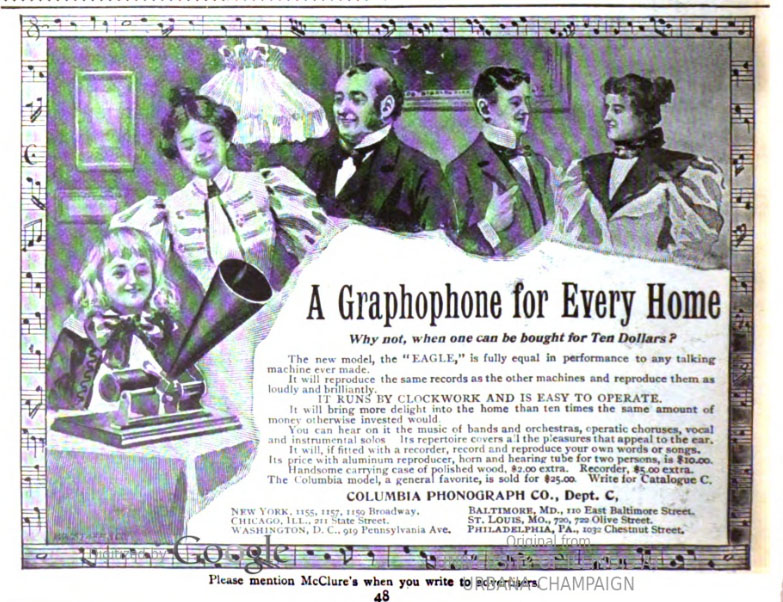
"A Graphophone for
Every Home." McClure's, October, 1897
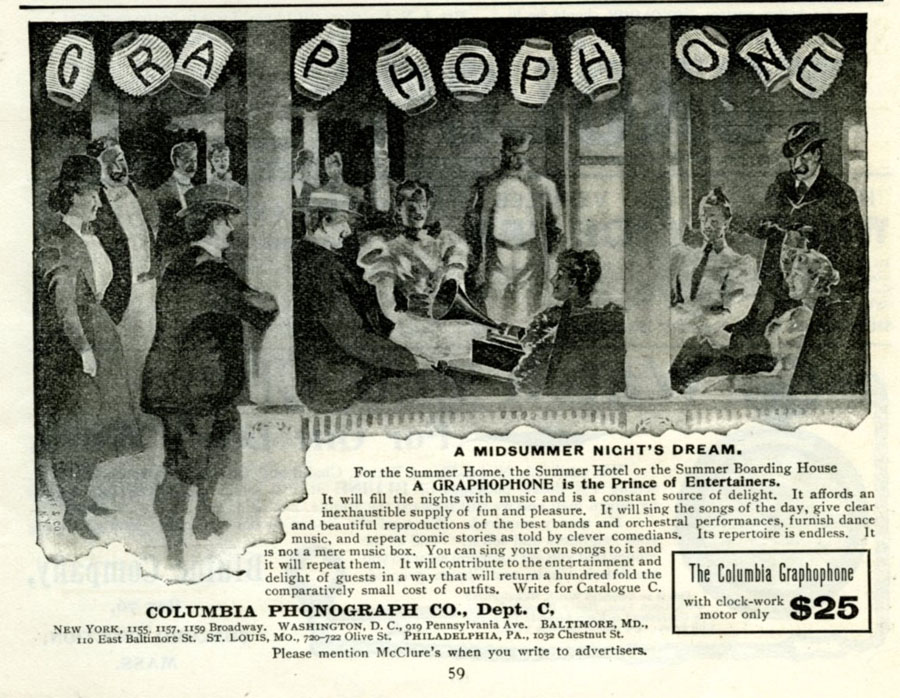
The Prince of Entertainers
- "It affords an inexhaustible supply of fun and pleasure."
McClure's, 1897 (PM-1011A)
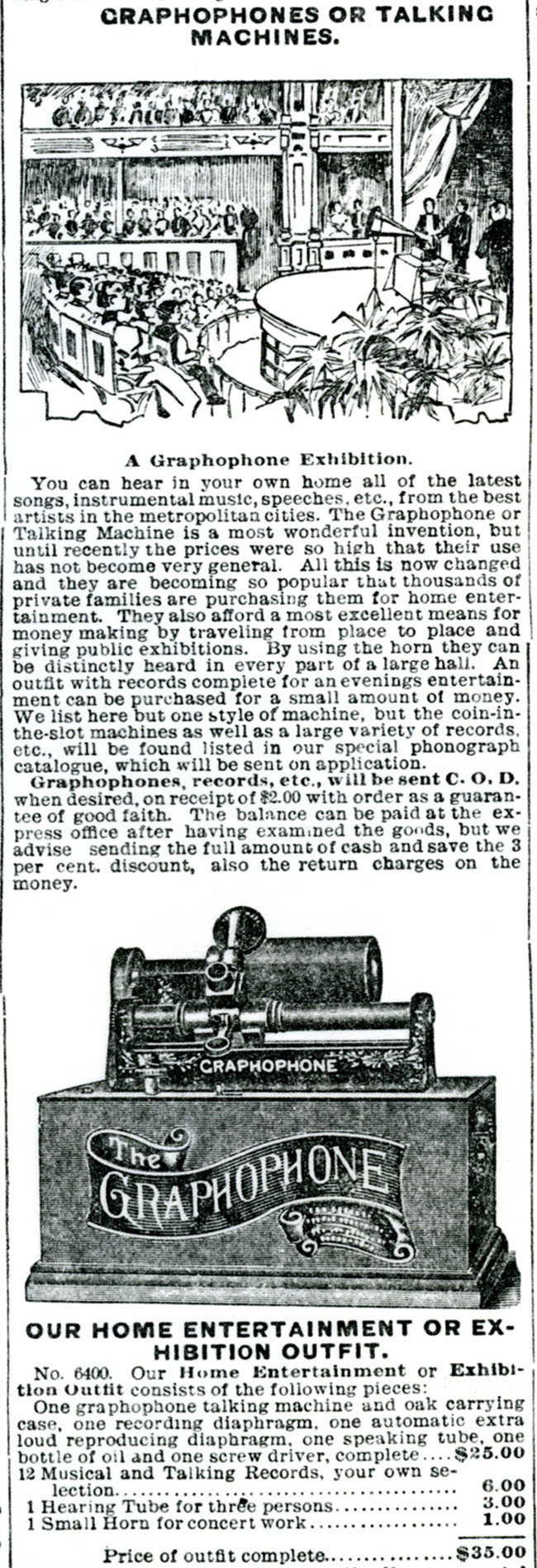
1897 Sears, Roebuck
& Co.,Cheapest Supply House on Earth, Chicago. p. 485
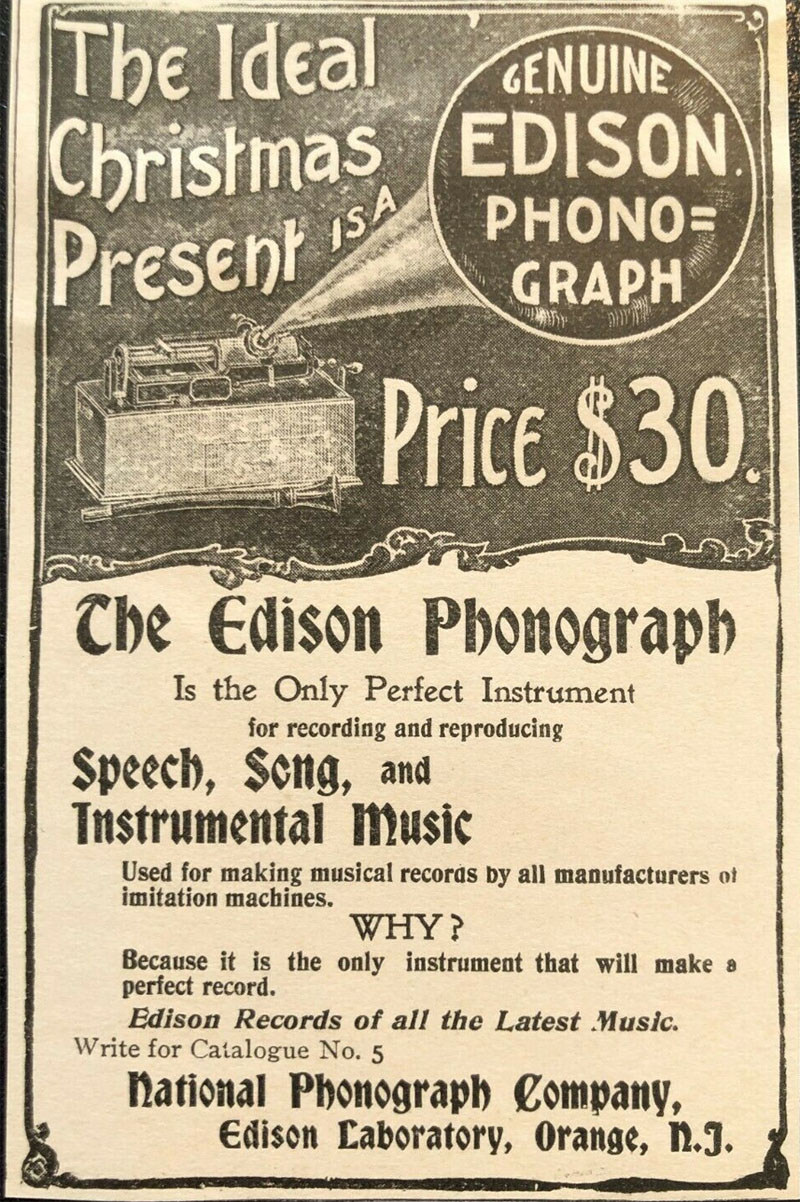
Munsey's Magazine,
December 1897
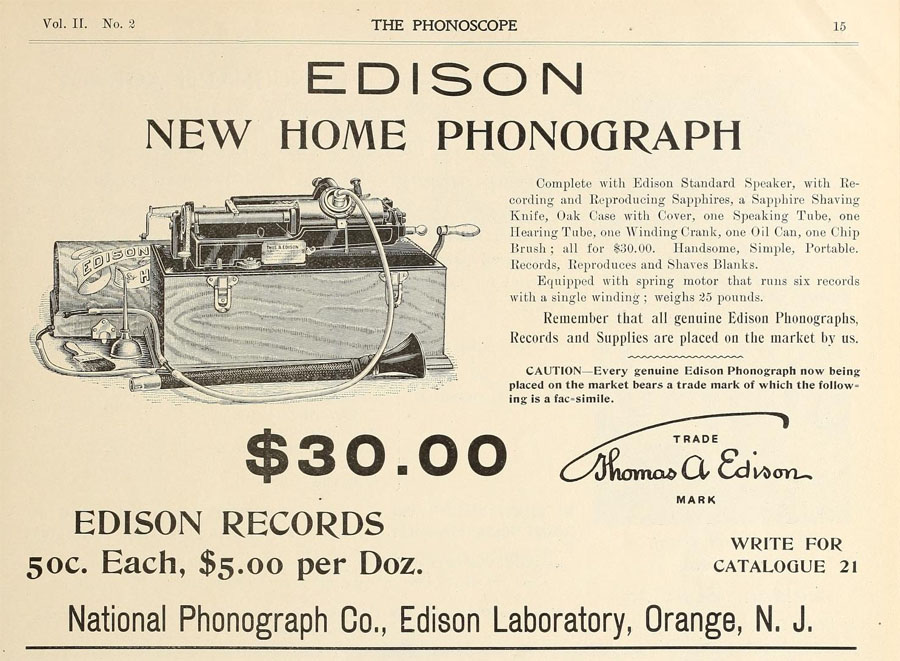
Edison trademark signature,
The Phonoscope, February 1898
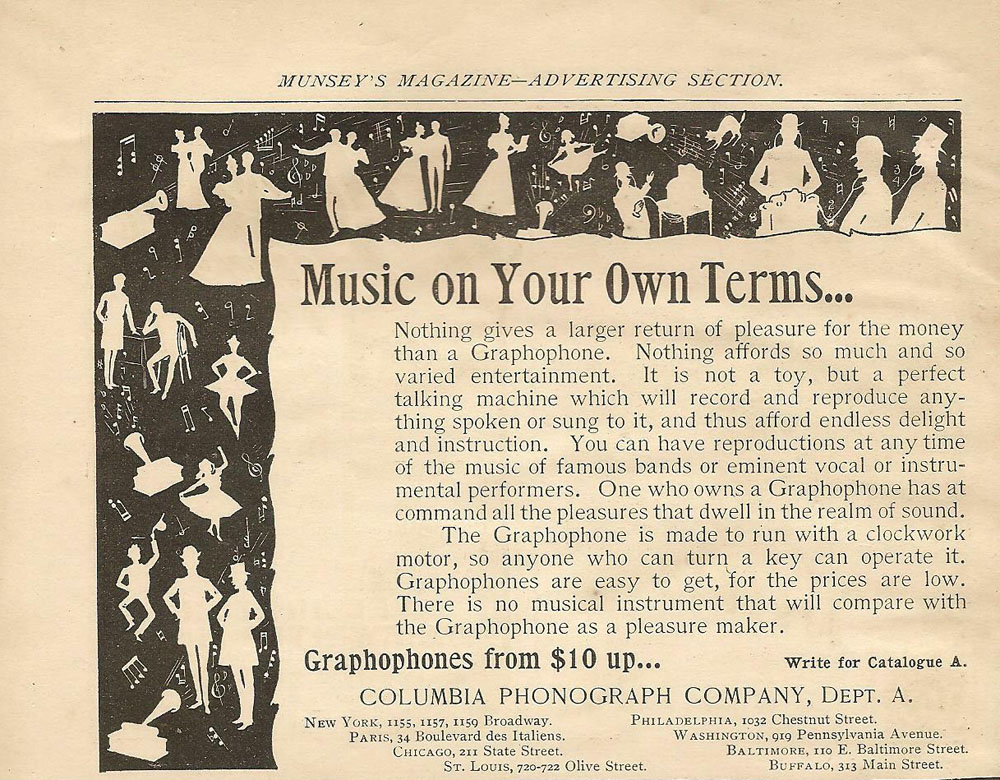
"Nothing gives a larger
return of pleasure for the money than a Graphophone." Munsey's
Magazine, March 1898

Munsey's Magazine,
May 1898 (PM-1010A)
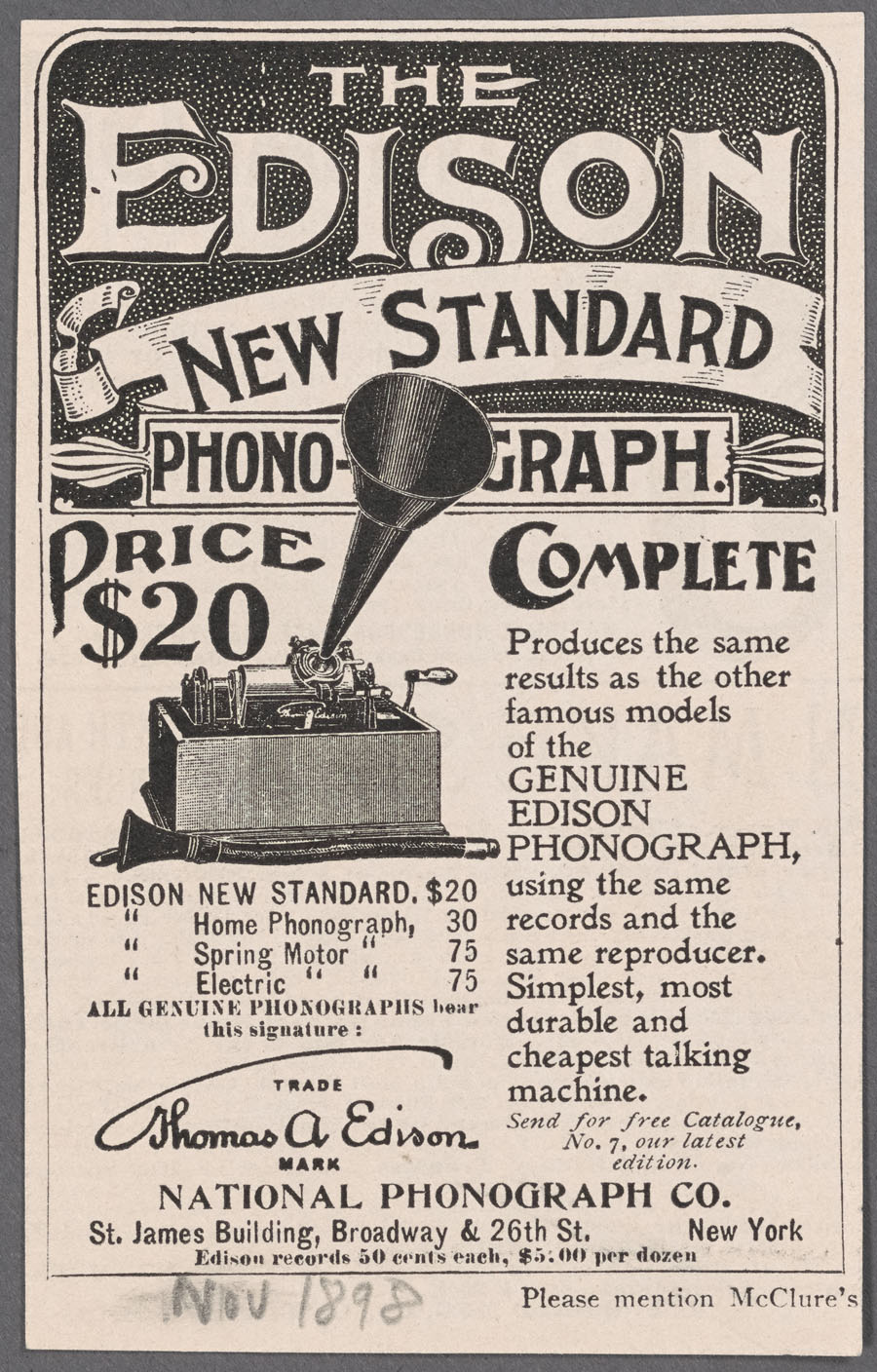
McClure's November
1898 Courtesy NYPL
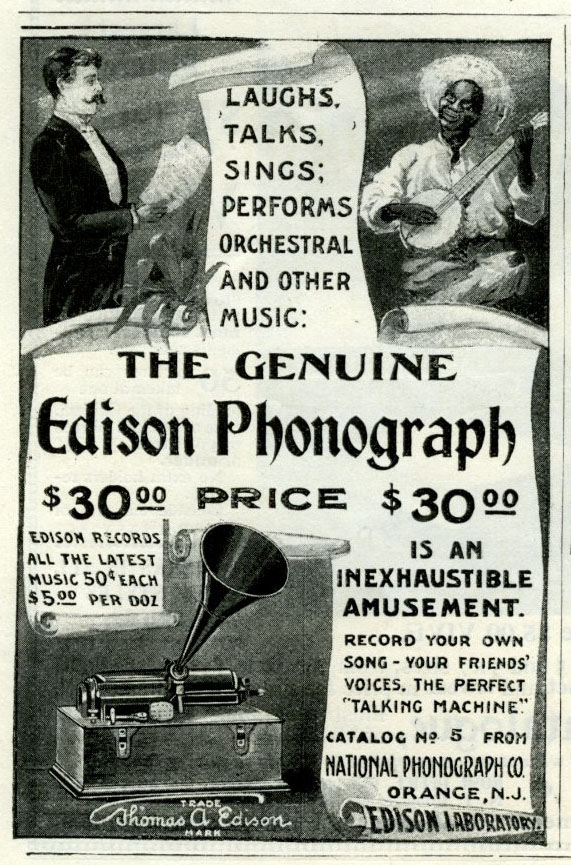
Laughs, Talks, Sings; Performs
Orchestral and Other Music. Record Your Own Song -- Your Friends' Voices.
Munsey's Magazine,
1898 (PM-0935)
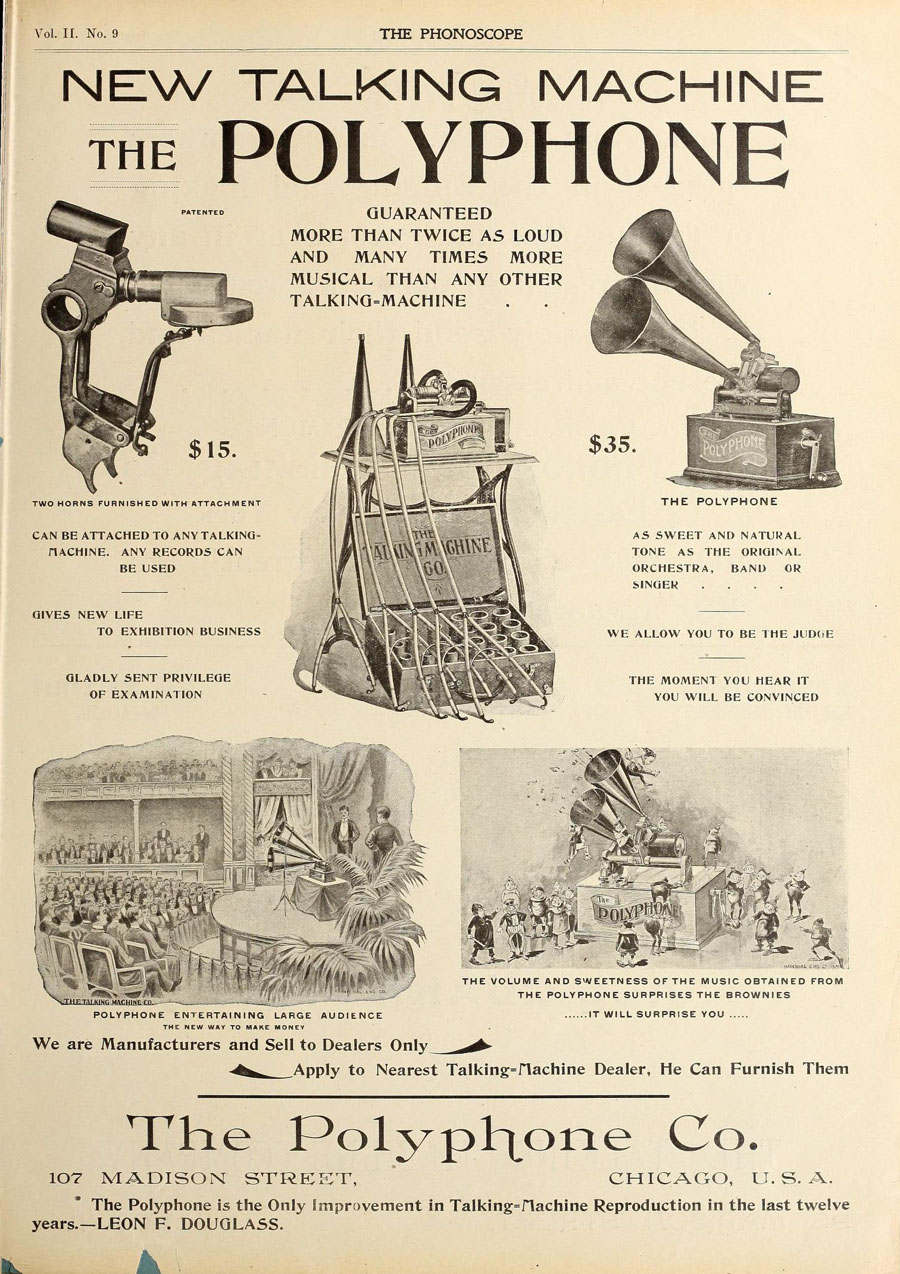
New Talking Machine The
Polyphone, The Polyphone Company, Chicago, Illinois, The Phonoscope,
September 1898

The Brownies are surprised
by the Polyphone, The Polyphone Company, Chicago, Illinois, The Phonoscope,
November 1898

The Improved Gram-o-Phone
(ZON-O-PHONE) The Ladie's Home Journal, October 1898
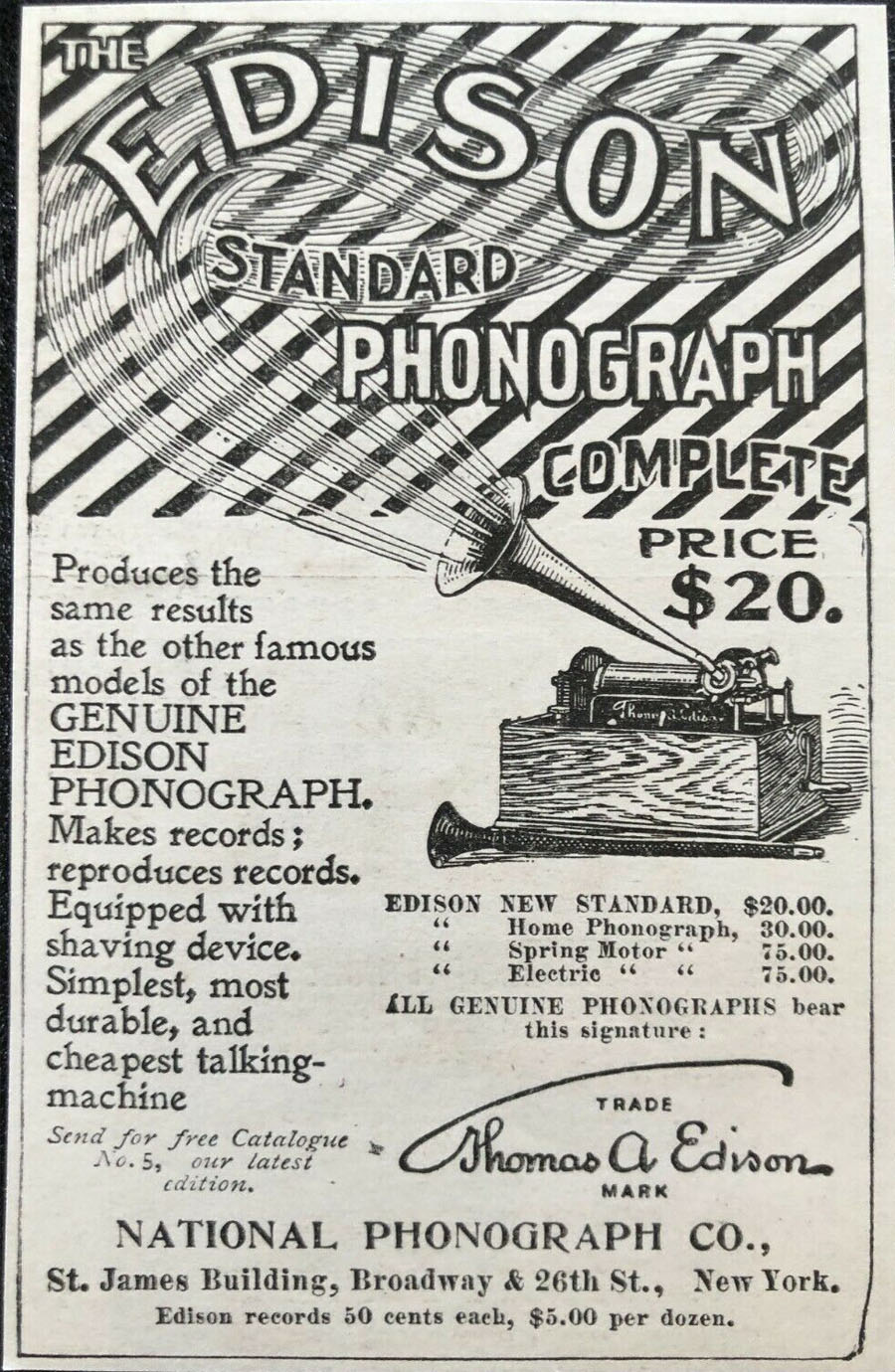
Munsey's Magazine,
December 1898
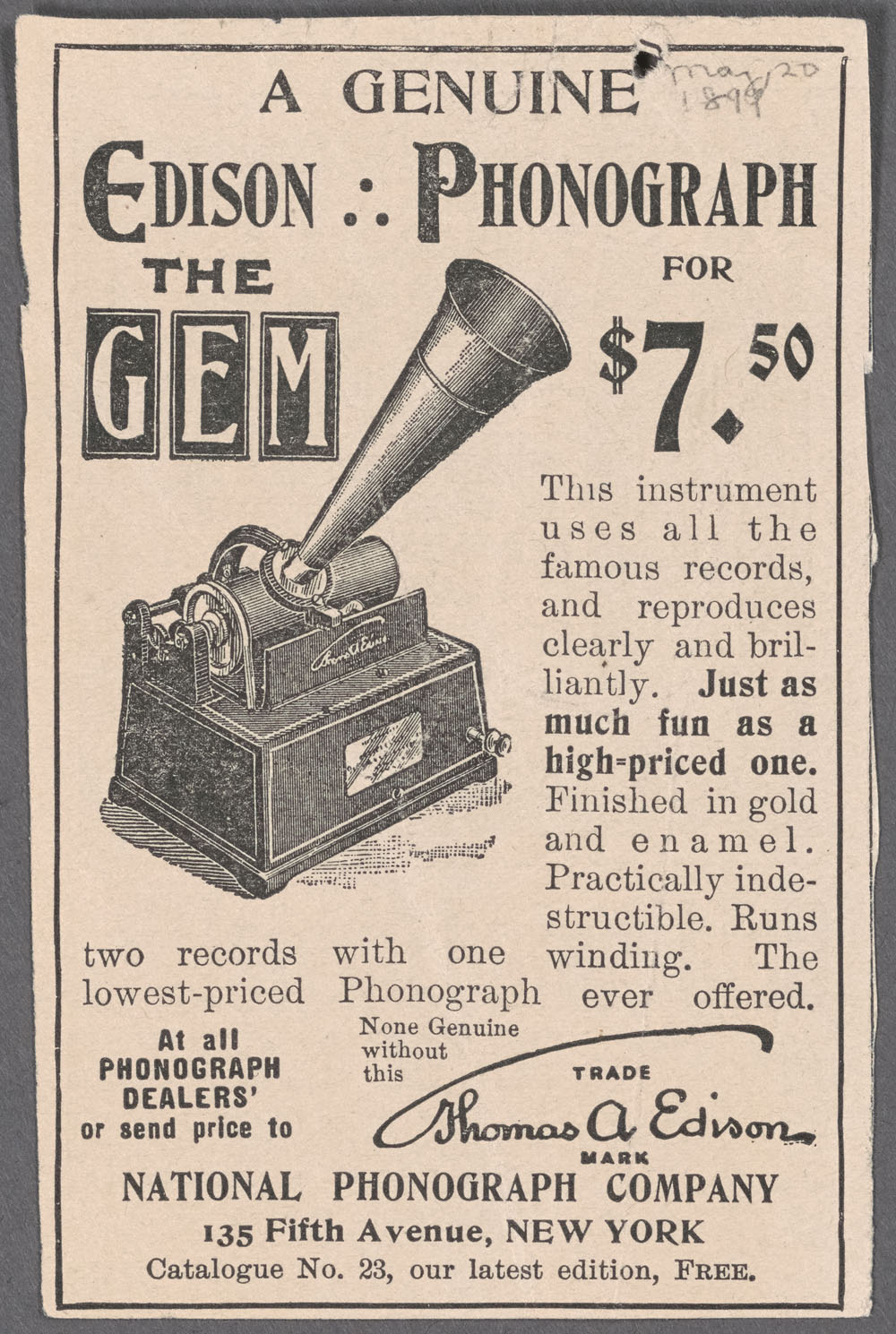
The Edison Gem, May 20,
1899 Courtesy NYPL
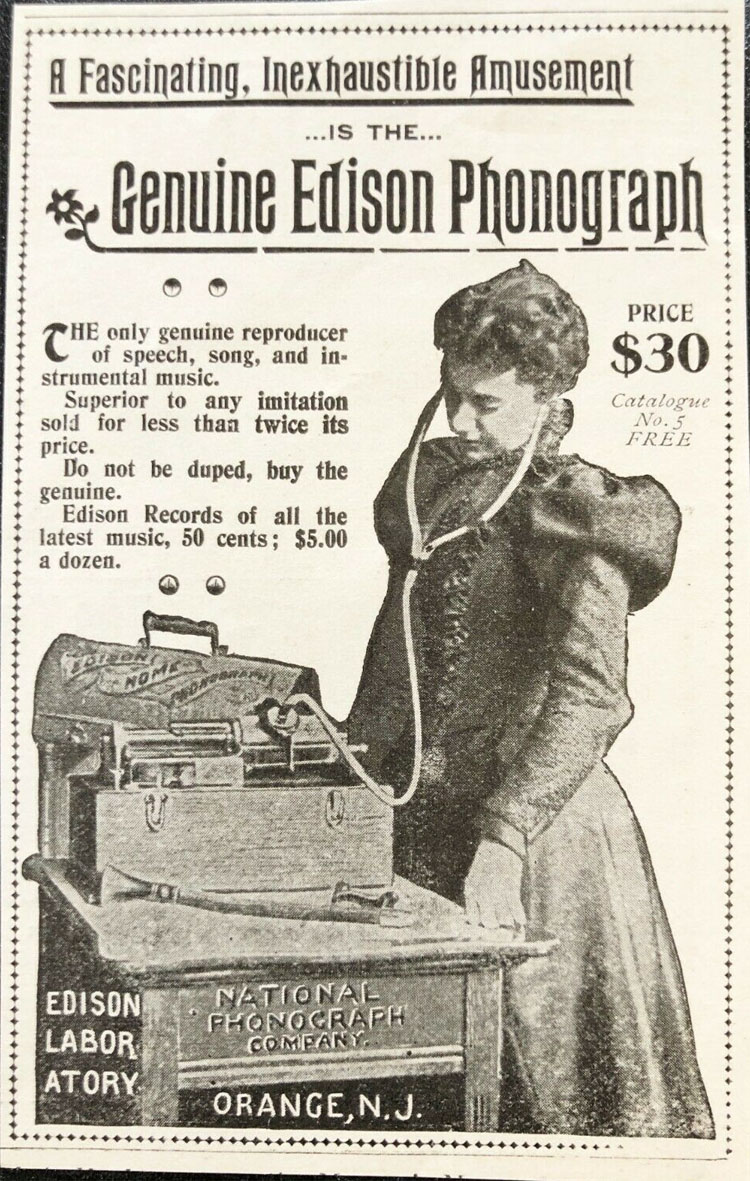
"Fascinating Inexhaustible
Amusement is the Genuine Edison Phonograph" - McClure's and
Munsey's magazines, January 1898
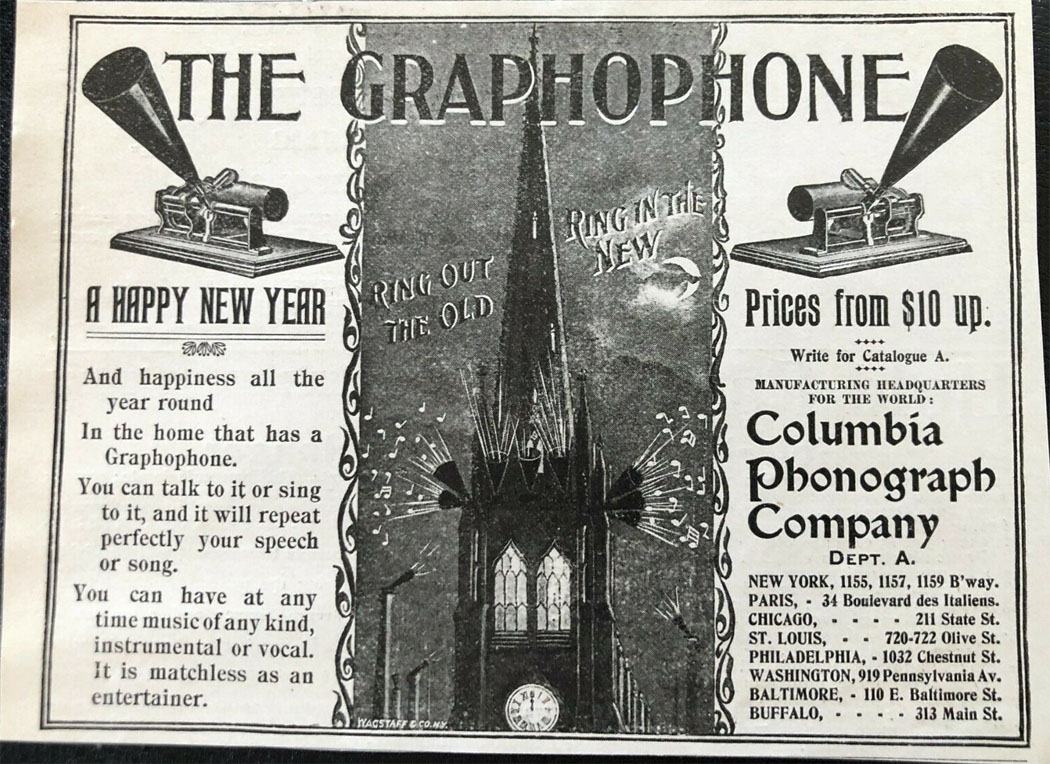
Munsey's Magazine,
January 1898
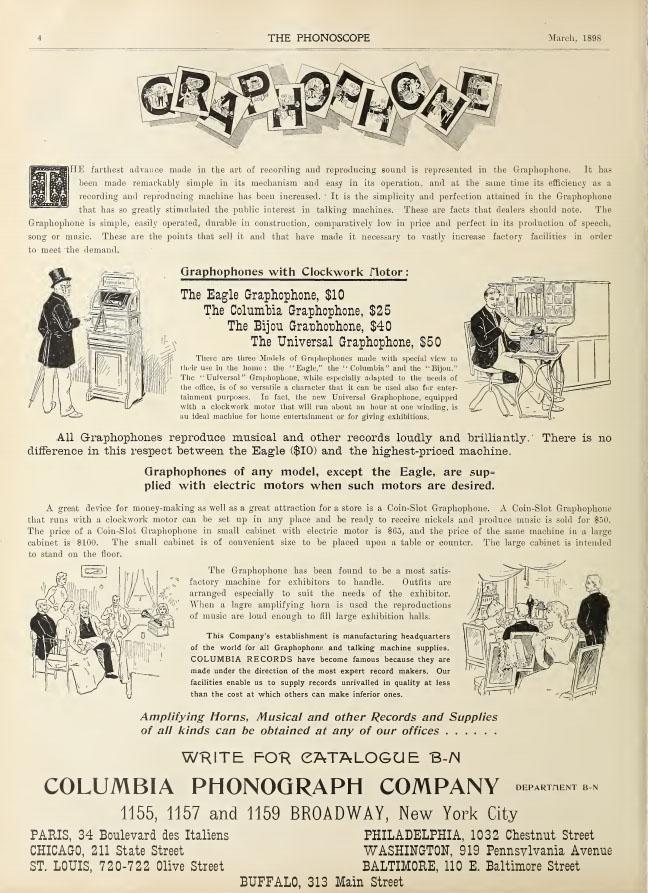
The Phonoscope,
March 1898
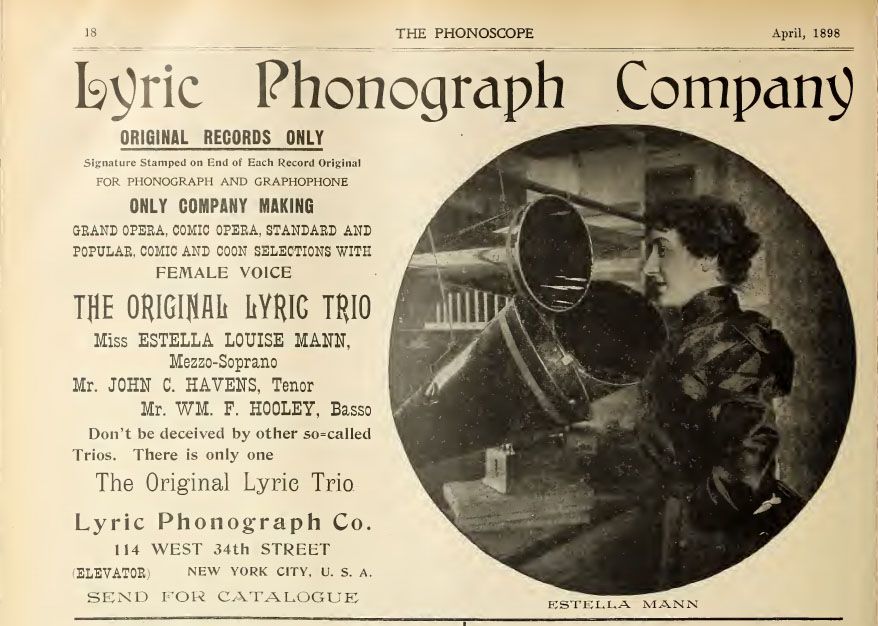
The Phonoscope,
March 1898
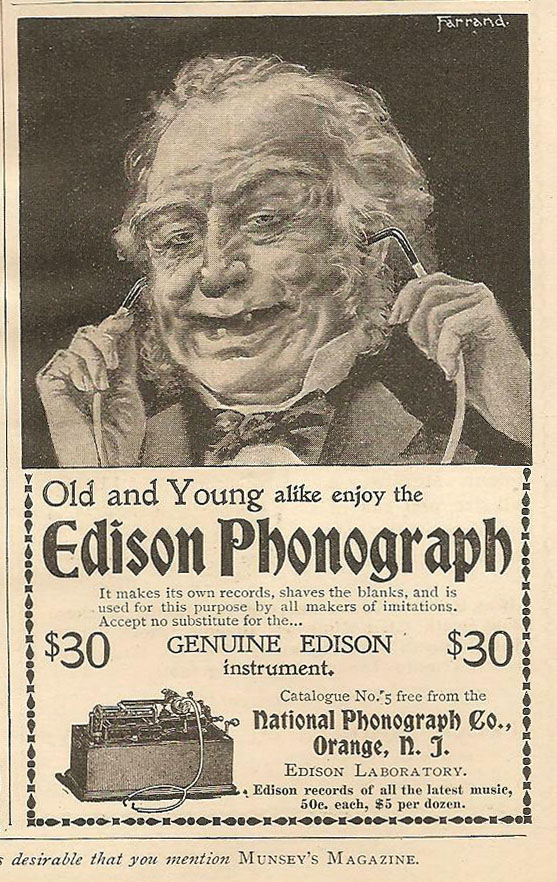
Munsey's Magazine,
March 1898
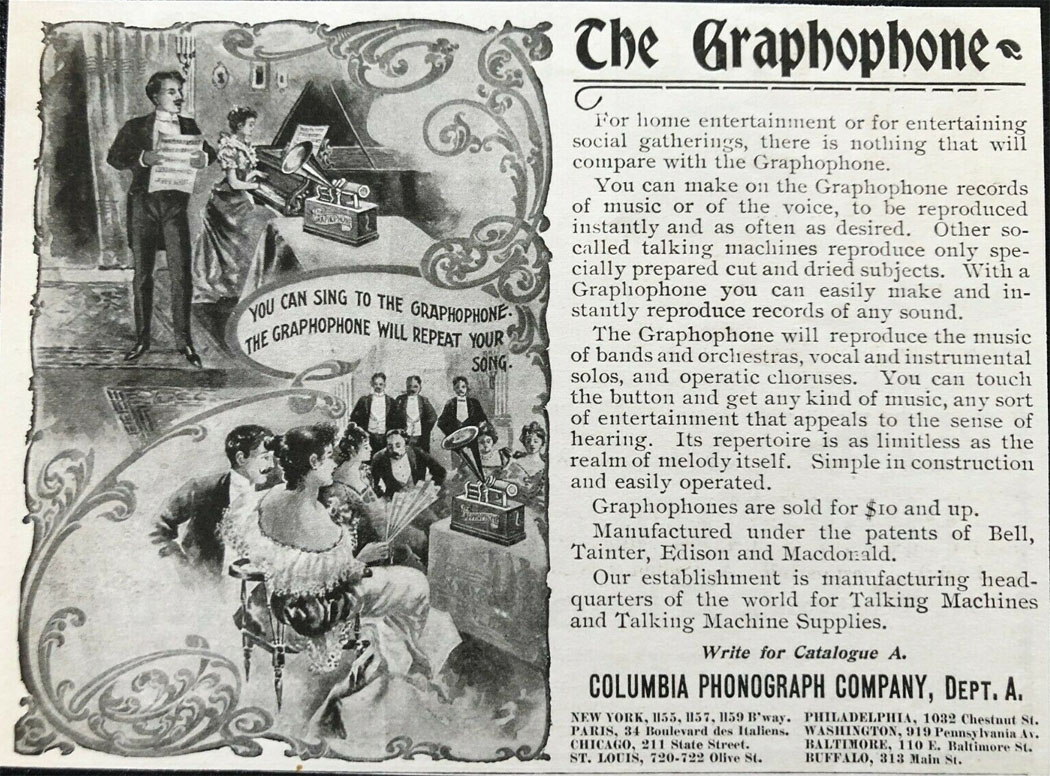
Munsey's Magazine,
May 1898
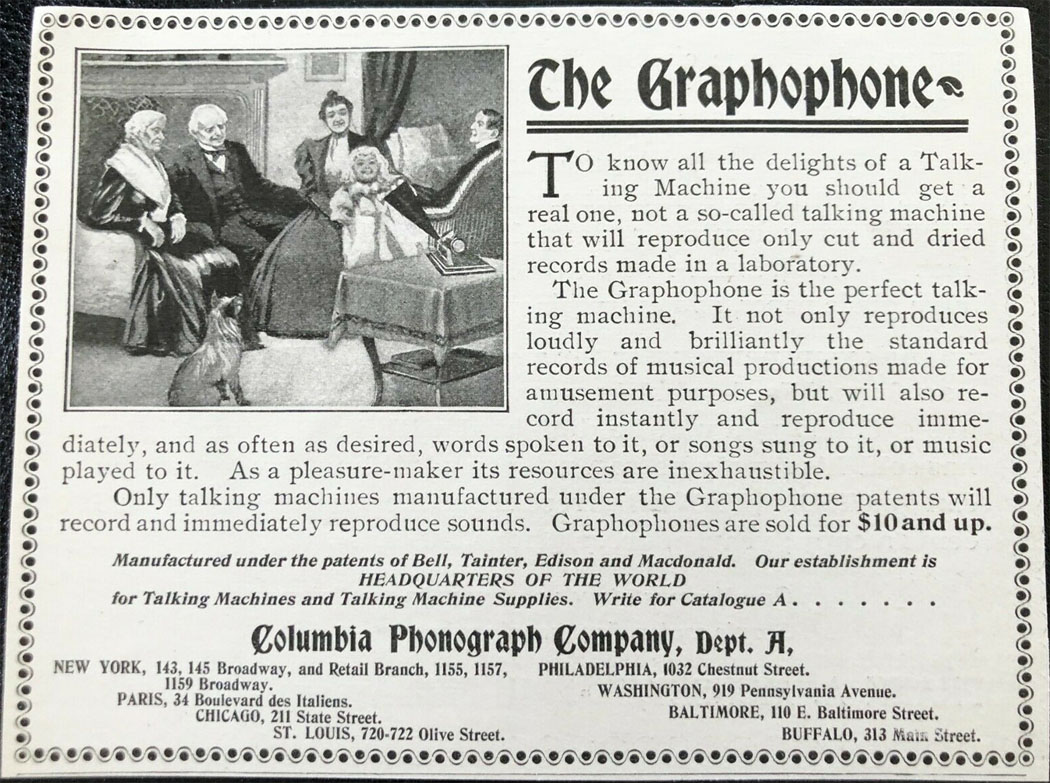
Munsey's Magazine,
July 1898
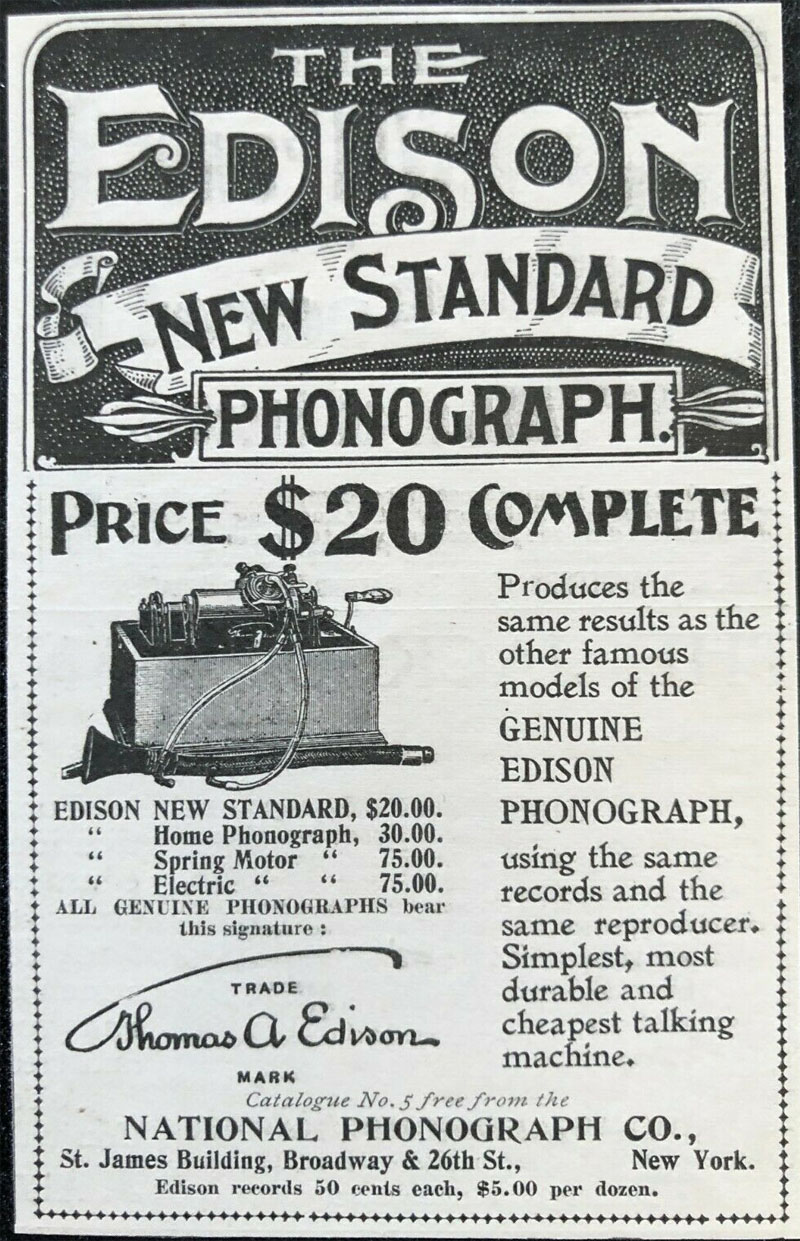
Munsey's Magazine,
July 1898
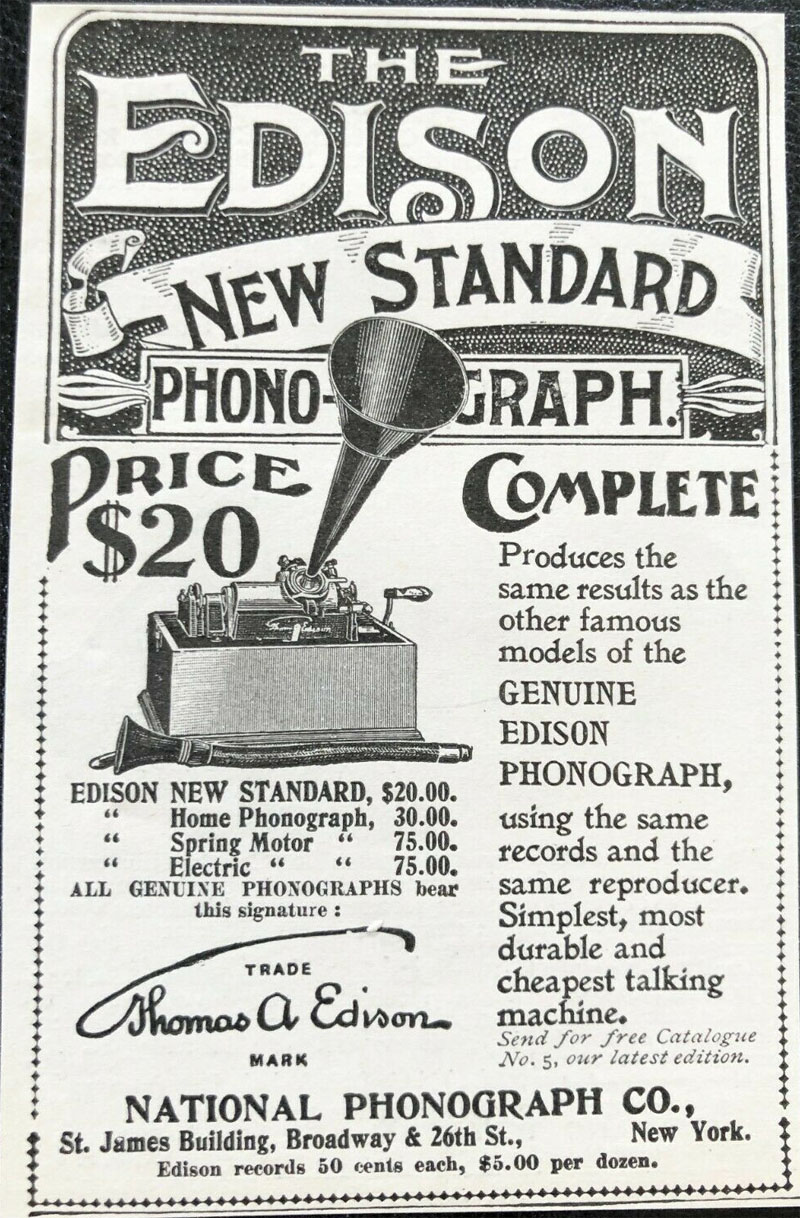
The Edison New Standard
Phonograph" - Munsey's Magazine, November 1898
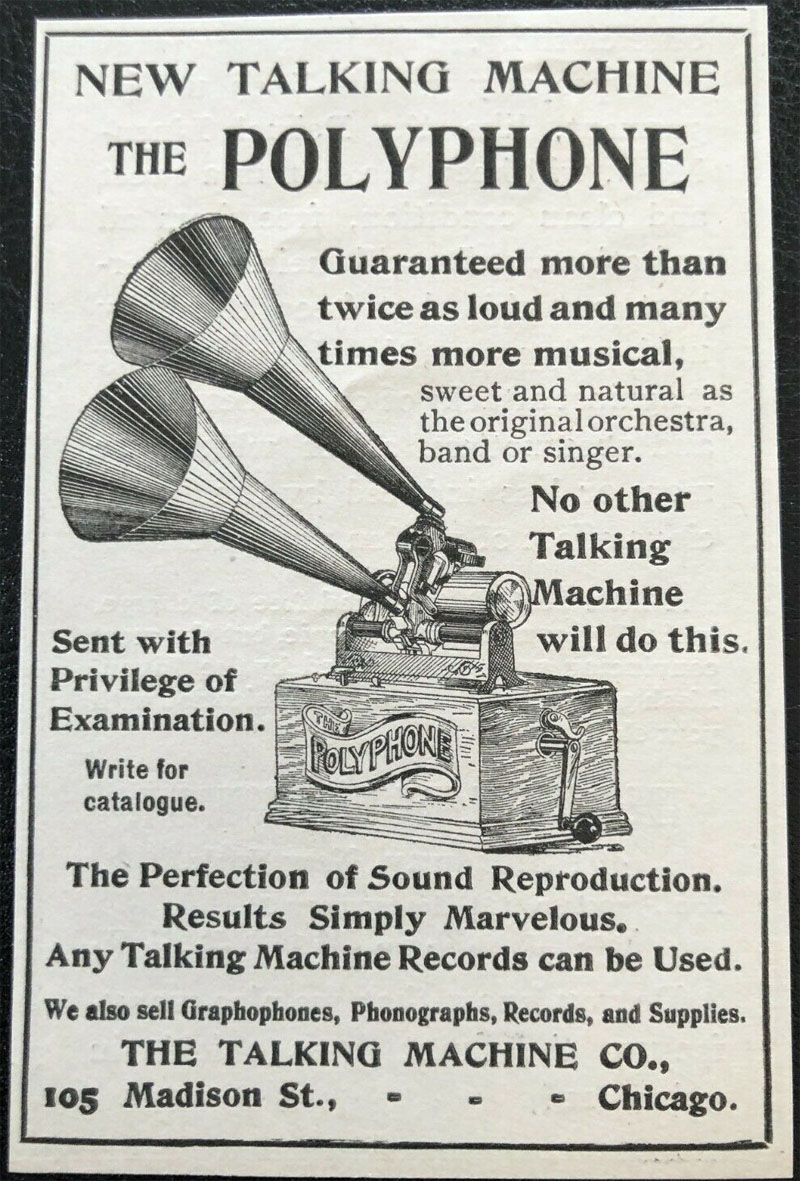
Munsey's Magazine,
November 1898
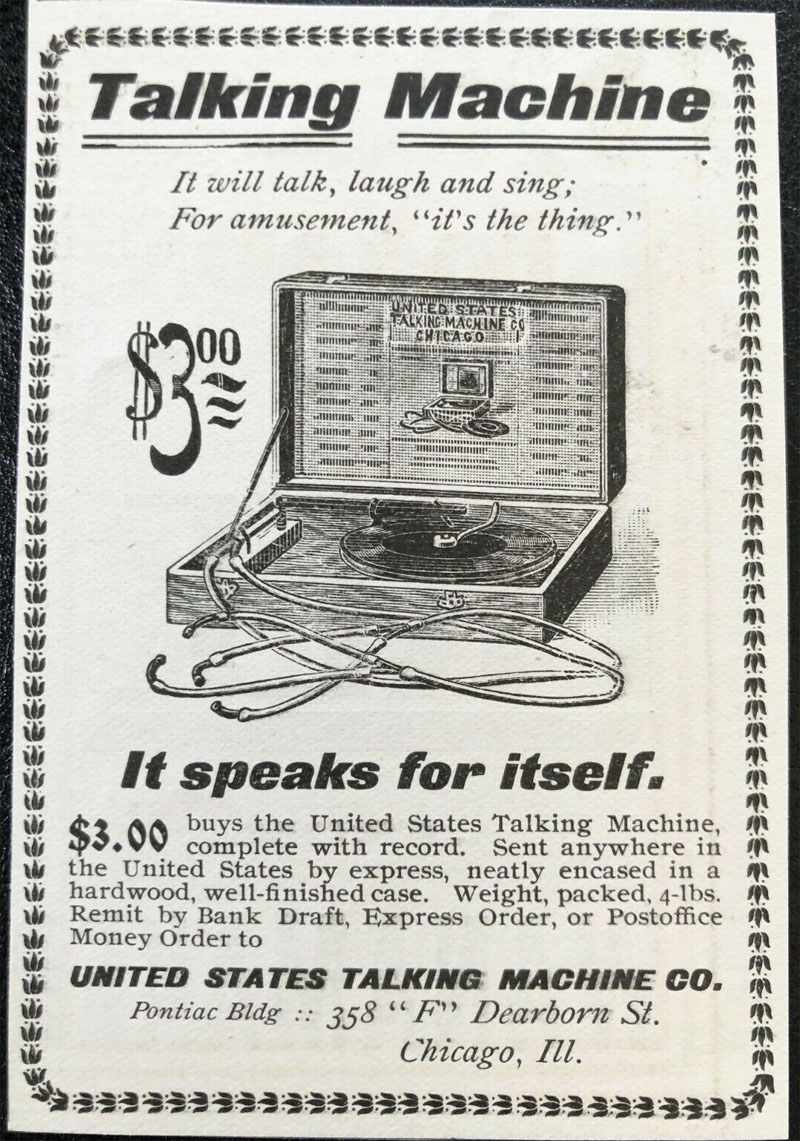
United States Talking
Machine Co., Munsey's Magazine, November 1898
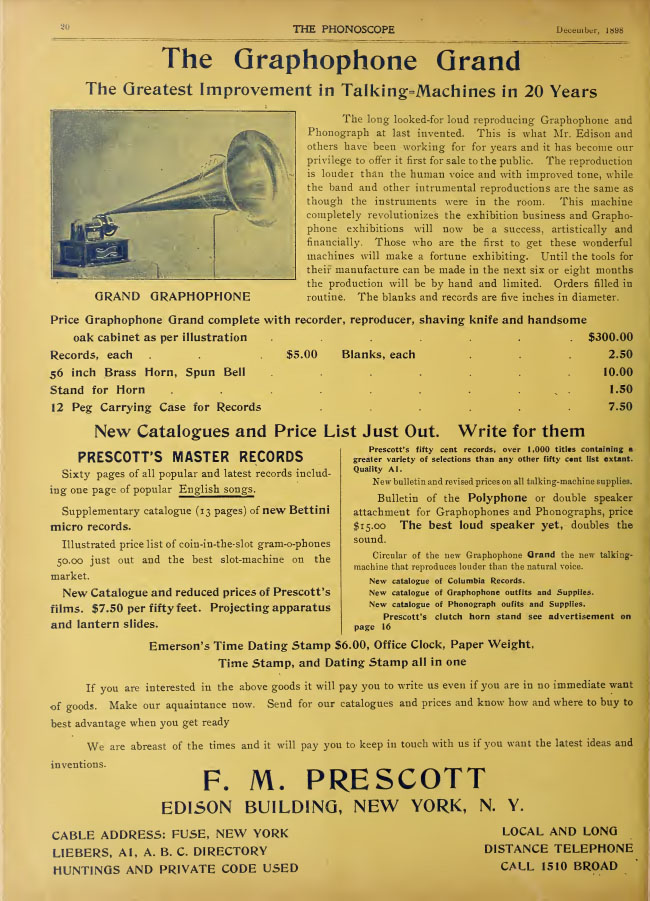
You can "make a fortune
exhibiting" with this wonderful machine. The Phonoscope,
December 1898
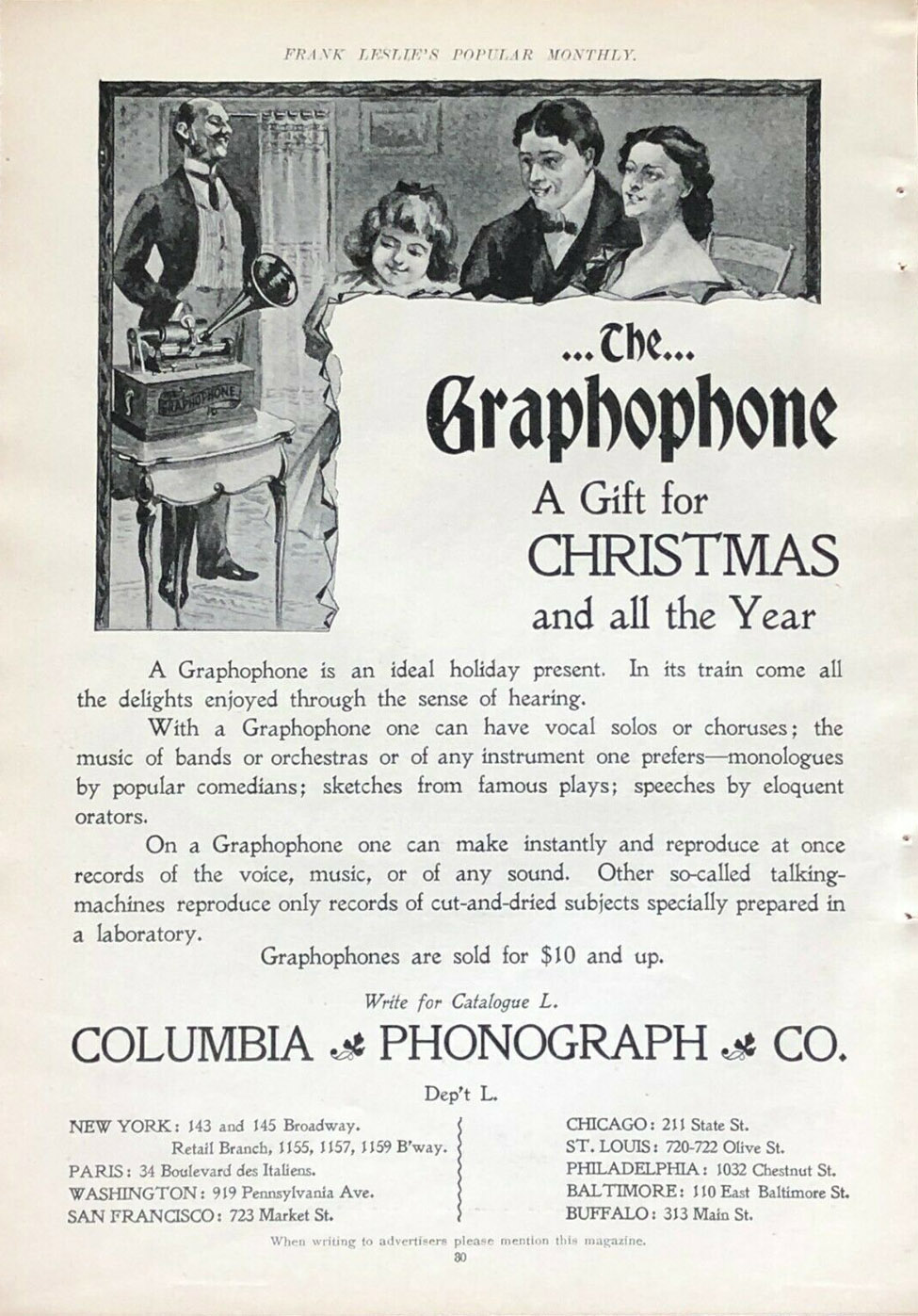
"A Gift for Christmas
and all the Year" Frank Leslie's Popular Magazine, December
1898 (PM-0922)

"The World's Greatest
Singers, Speakers and Players at your own home! Like a living thing,
with a thousand voices." The Cosmopolitan, March 1899
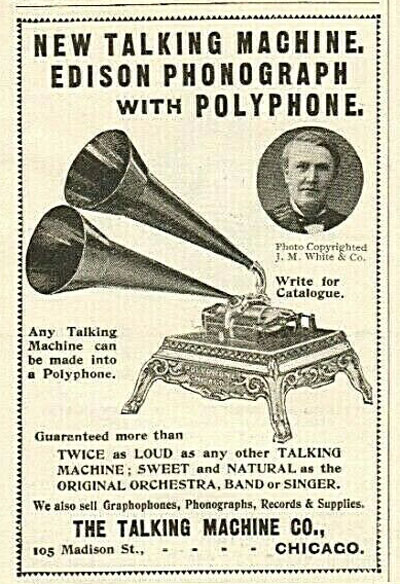
Quarter-page ad for Edison
Phonograph, Munsey's Magazine, 1899
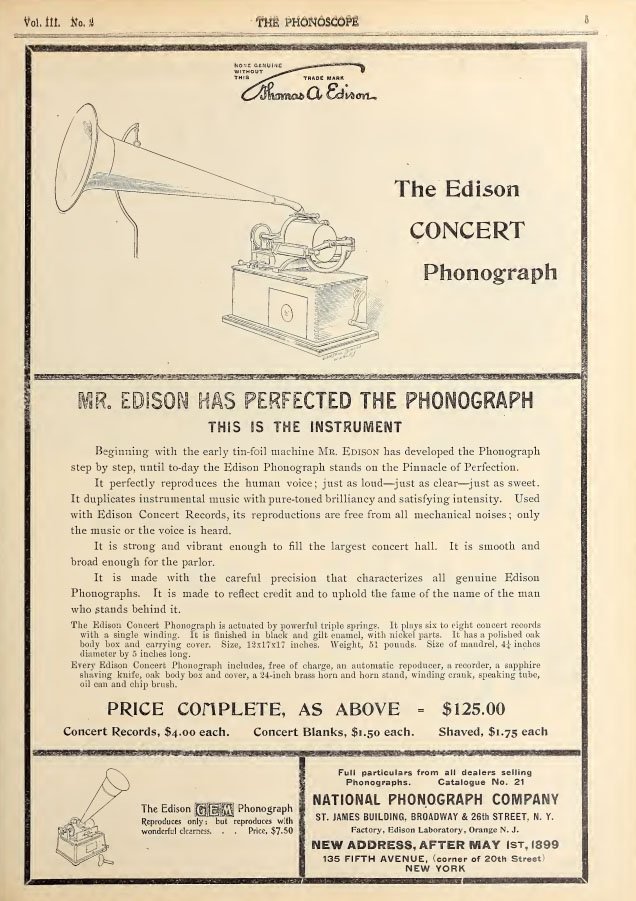
"The Pinnacle of Perfection,"
The Phonoscope, February 1899
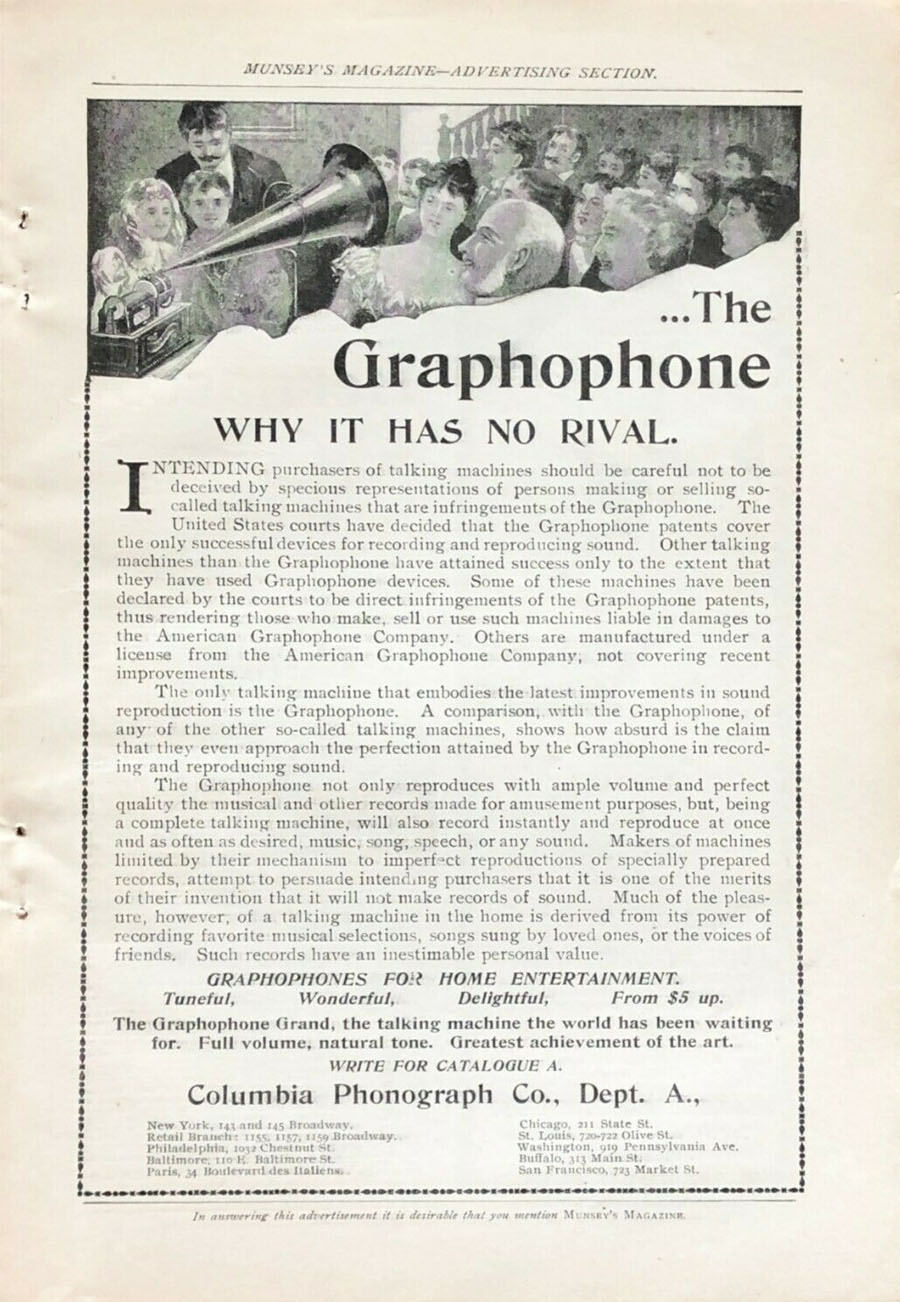
"The Graphophone -
Why It Has No Rival." Munsey's, February 1899, 6 3/4" x
9 3/4" (PM-0923)
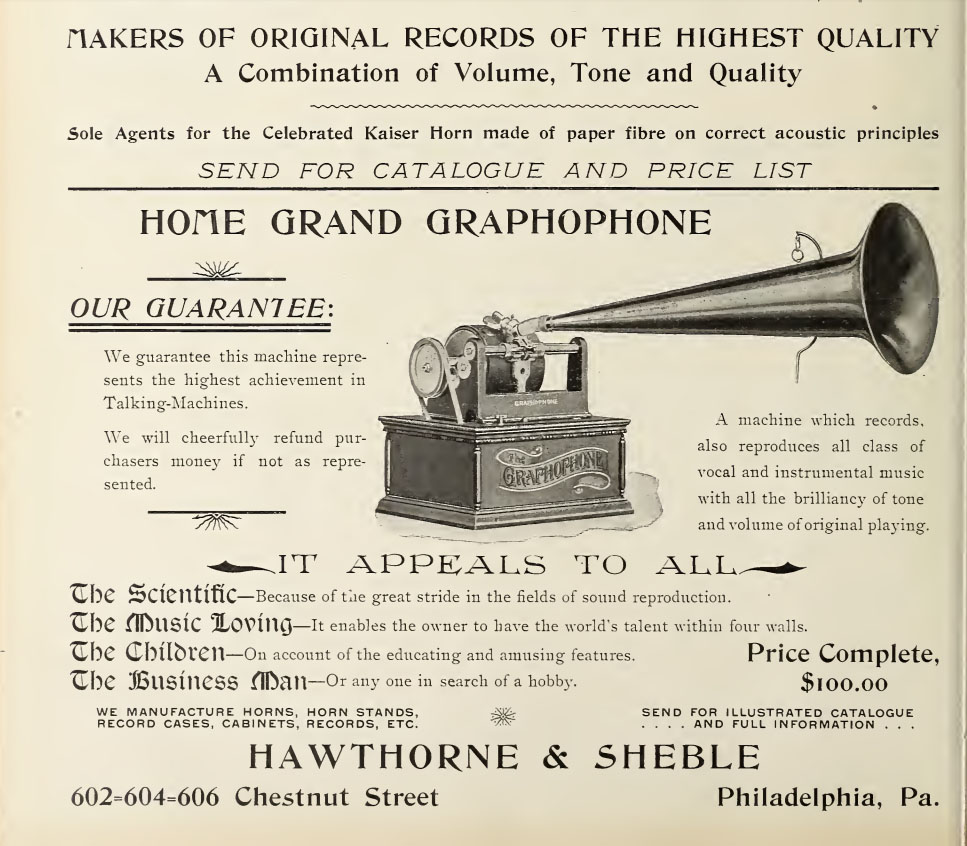
"It enables the owner
to have the world's talent within four walls." The Phonoscope,
March 1899
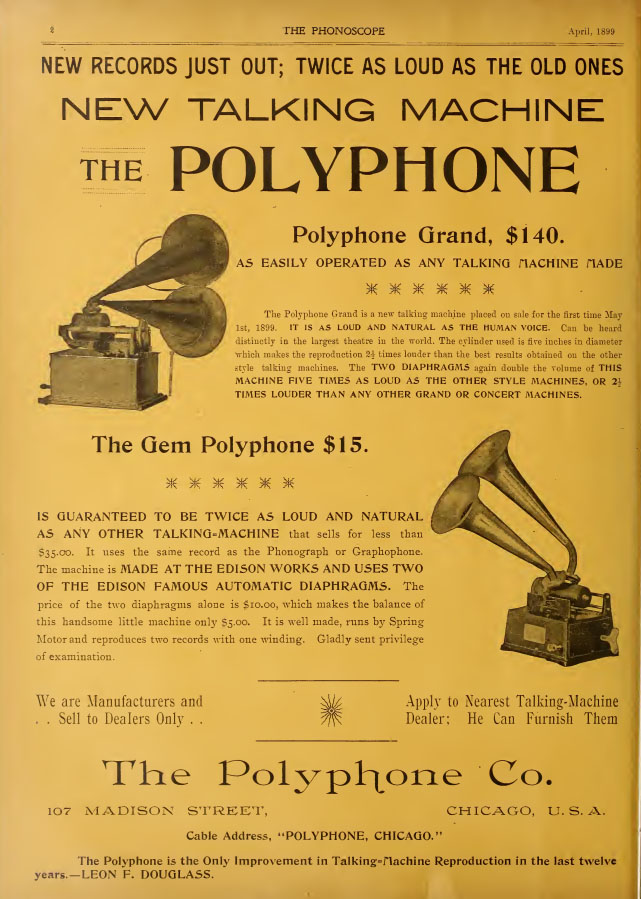
The Phonoscope,
March 1899
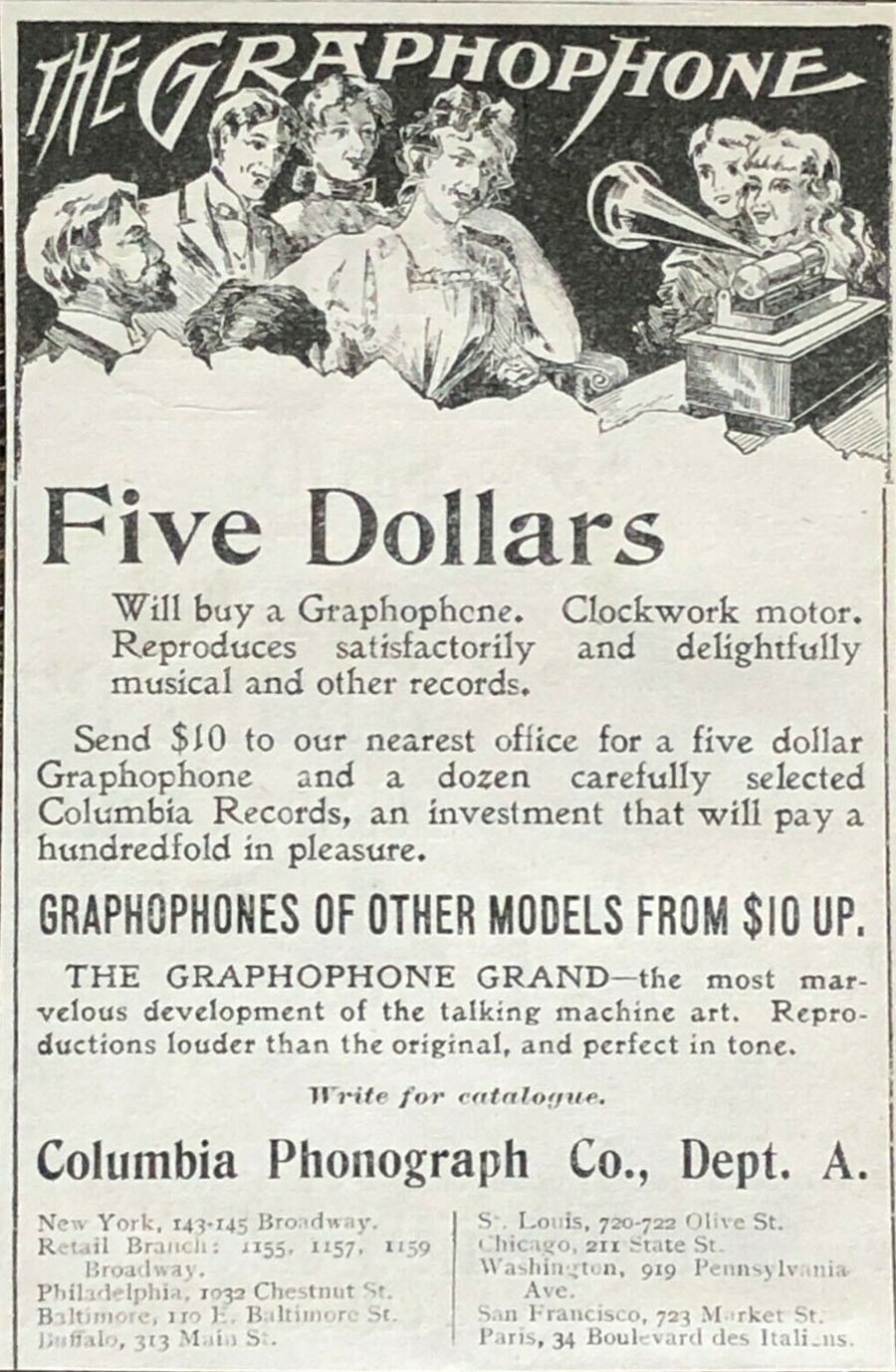
"The Graphophone -
Five Dollars" Munsey's, April 1899, 2 3/4" x 4"
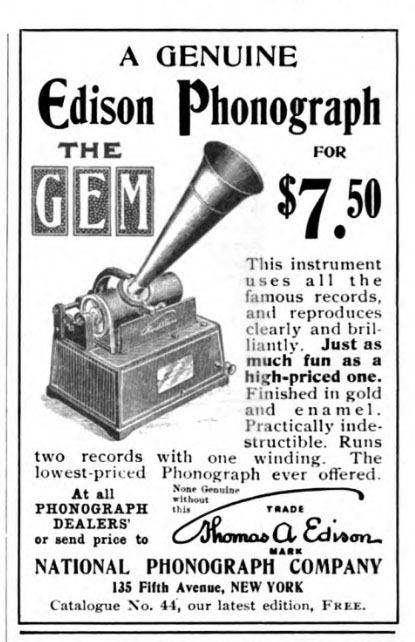
The Saturday Evening
Post, May 27, 1899
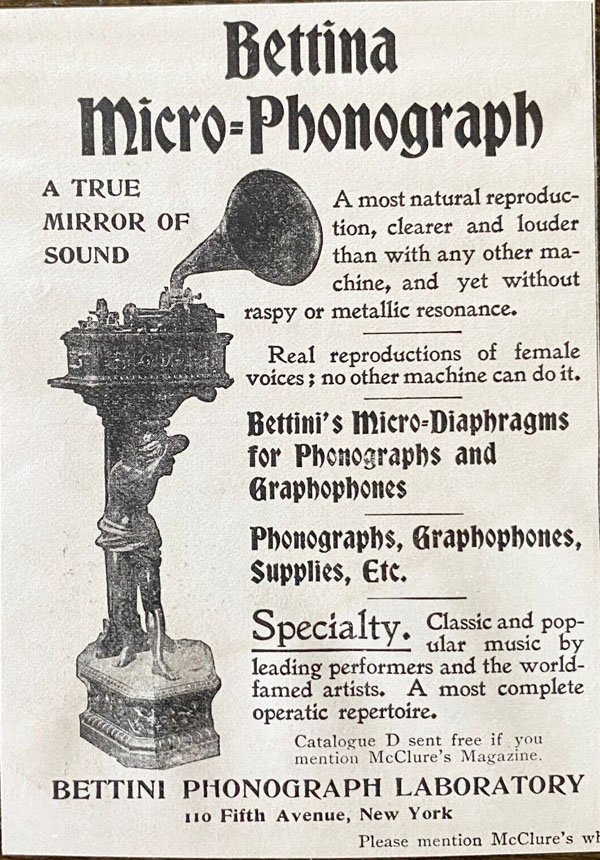
McClure's Magazine,
June, 1899 (2 3/4" x 4")
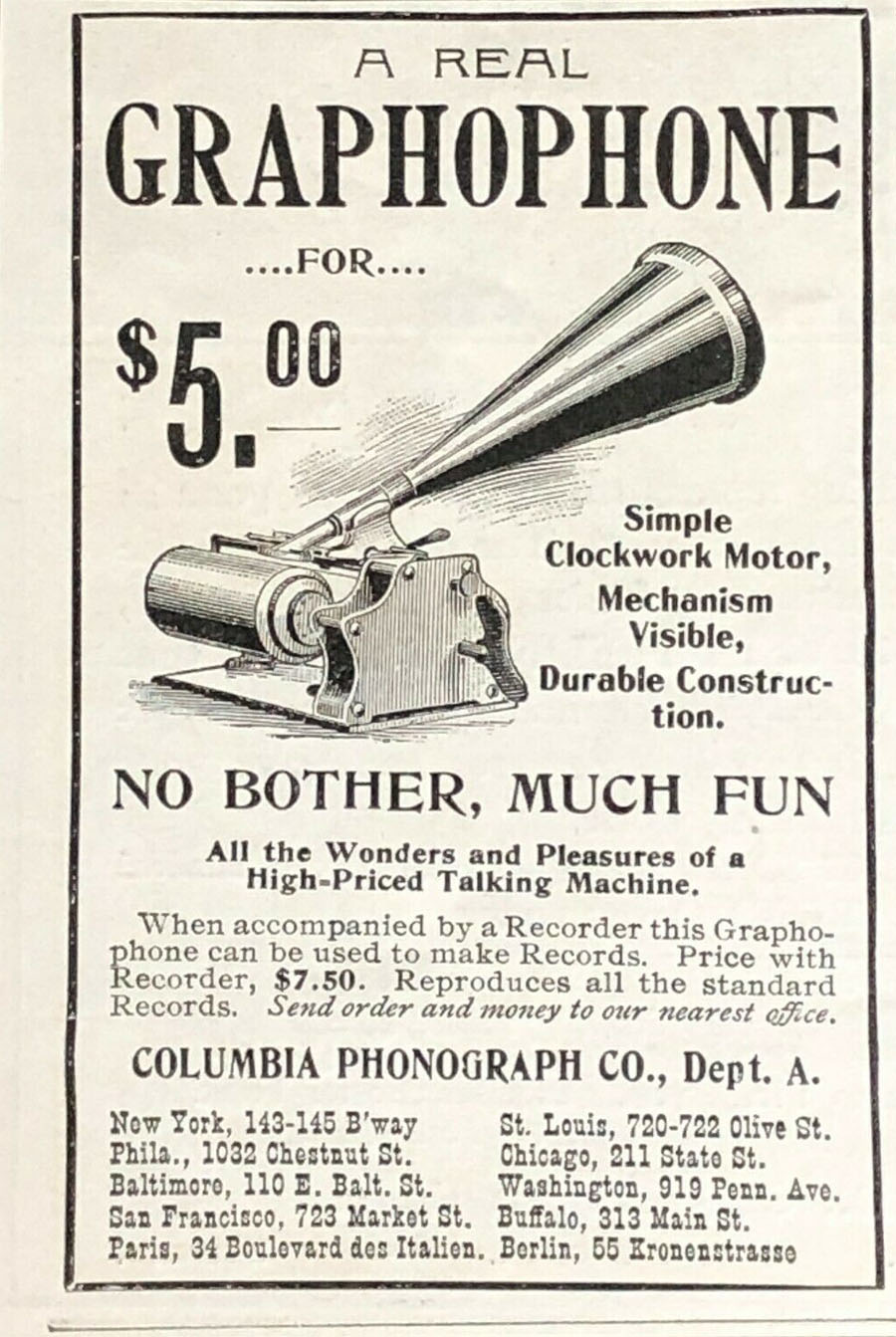
"No Bother, Much Fun"
Munsey's, July 1899, 2 3/4" x 4"
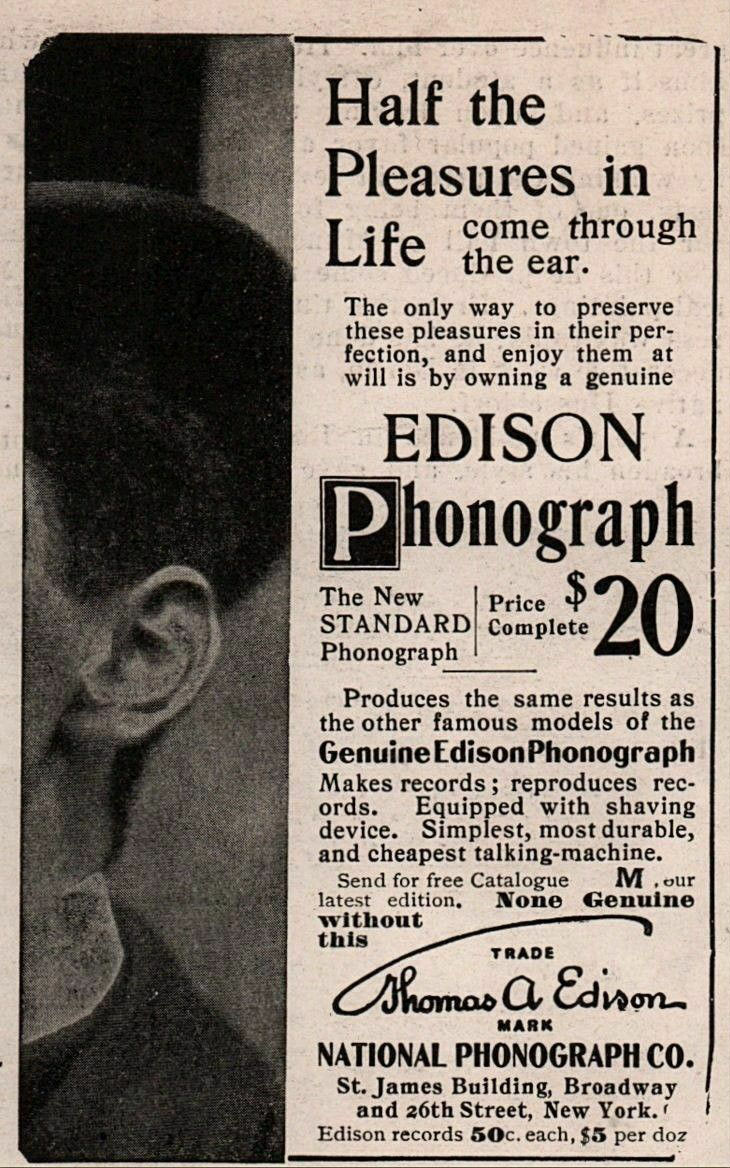
Munsey's Magazine,
February 1899, 2 3/4" x 4"
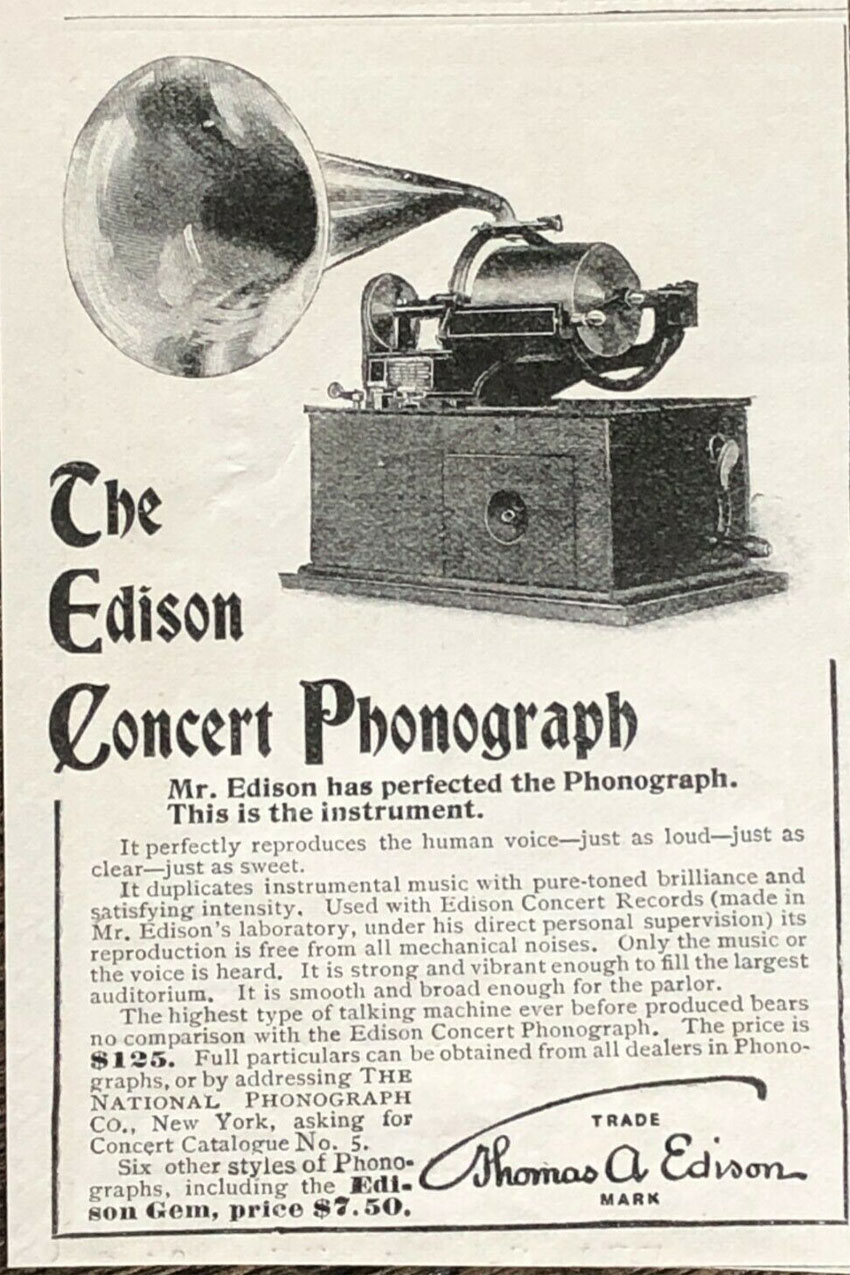
The Edison Concert Phonograph,
Munsey's, May 1899, 2 3/4" x 4"
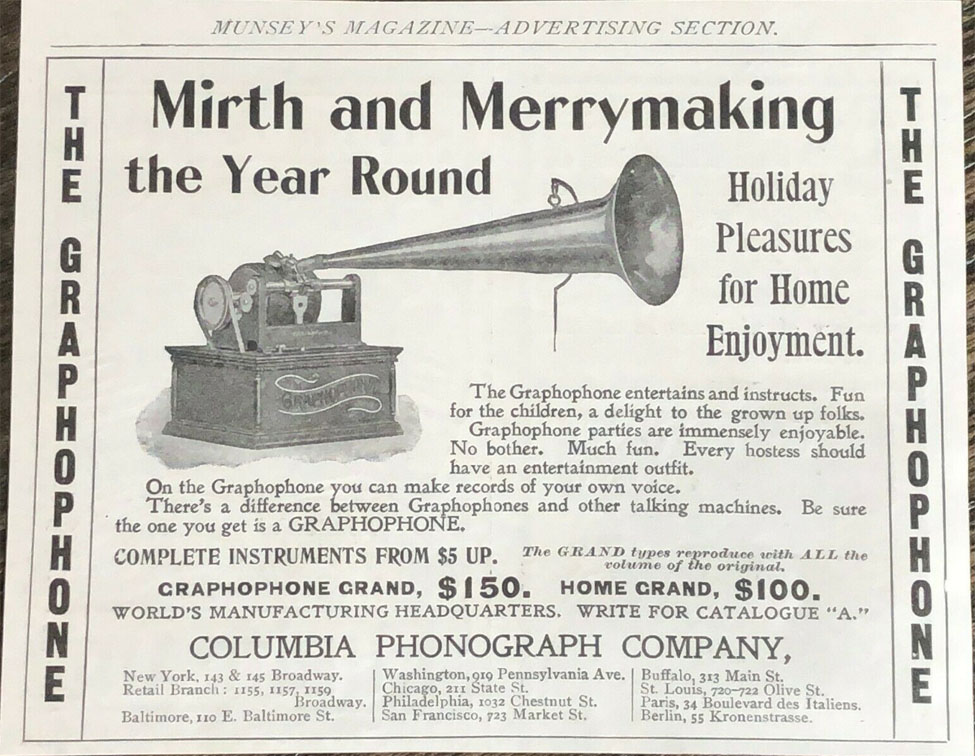
"Mirth and merrymaking
the Year Round" Munsey's, December 1899, 4" x 5.5"
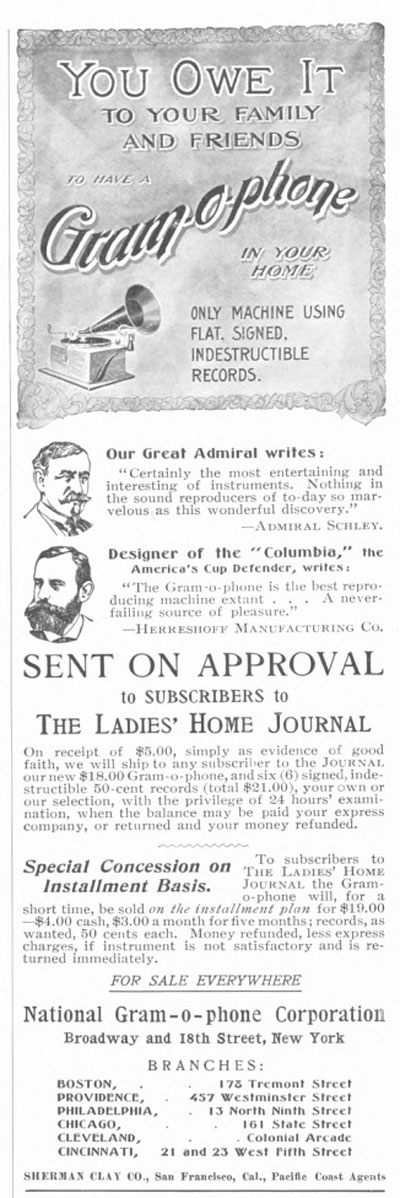
The Ladies' Home Journal,
December 1899, p. 19 (1/8 page)

Harper's Weekly,
April 1899 (1/4 page - see
full page with all ads).
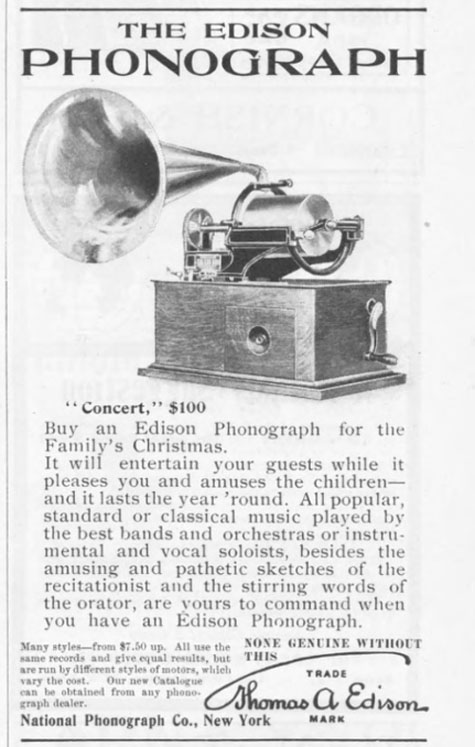
November 1899 (1/4 page)

The Ladies' Home Journal,
December 1899 (1/16 page ads - See
full page 44)
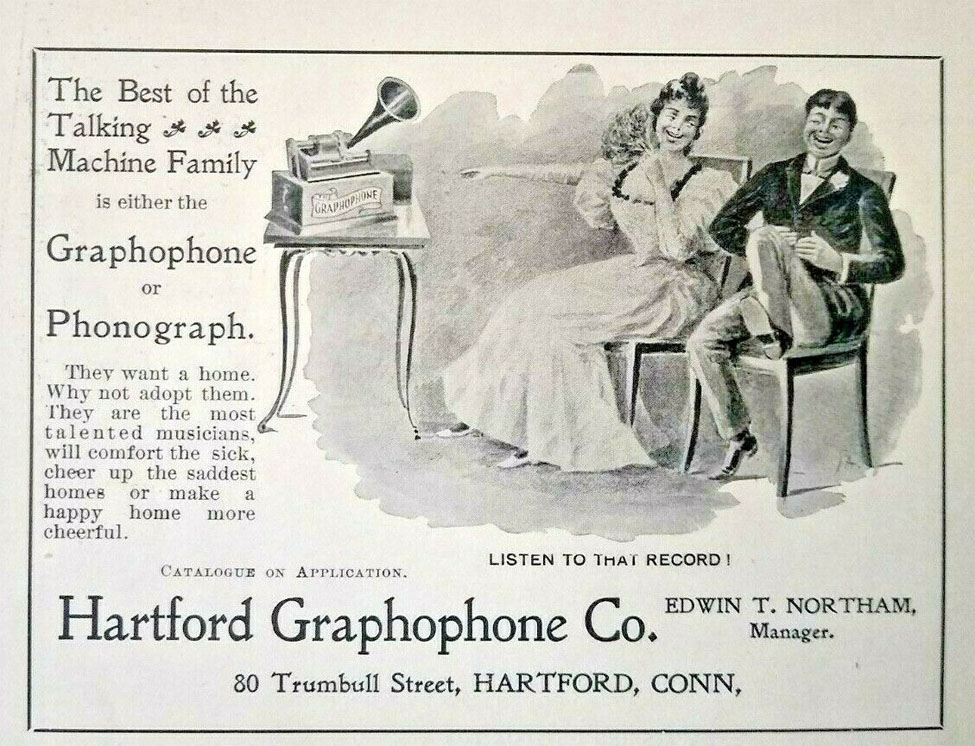
Hartford Graphophone Co.,
1899

|

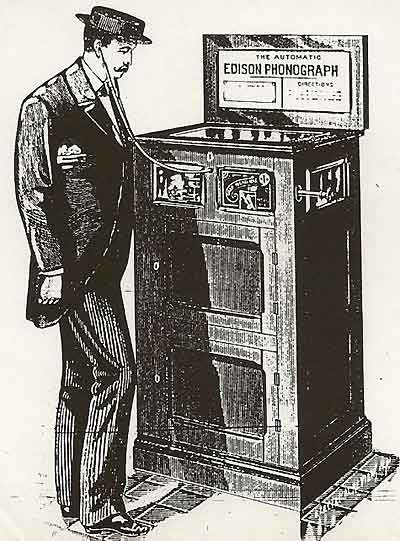






















 eatest
Musicians, Singers, Actors and Speakers..." 1896
eatest
Musicians, Singers, Actors and Speakers..." 1896






























































